

ALL FISH • ALL WATERS // WINTER 2022 flyfishersinternational.org Bowfin Hunter Targeting ancient air breathers CHESAPEAKE PERFORMANCE A critical watershed with innumerable opportunities Lucky Sevens 7 days, 7 unique fisheries
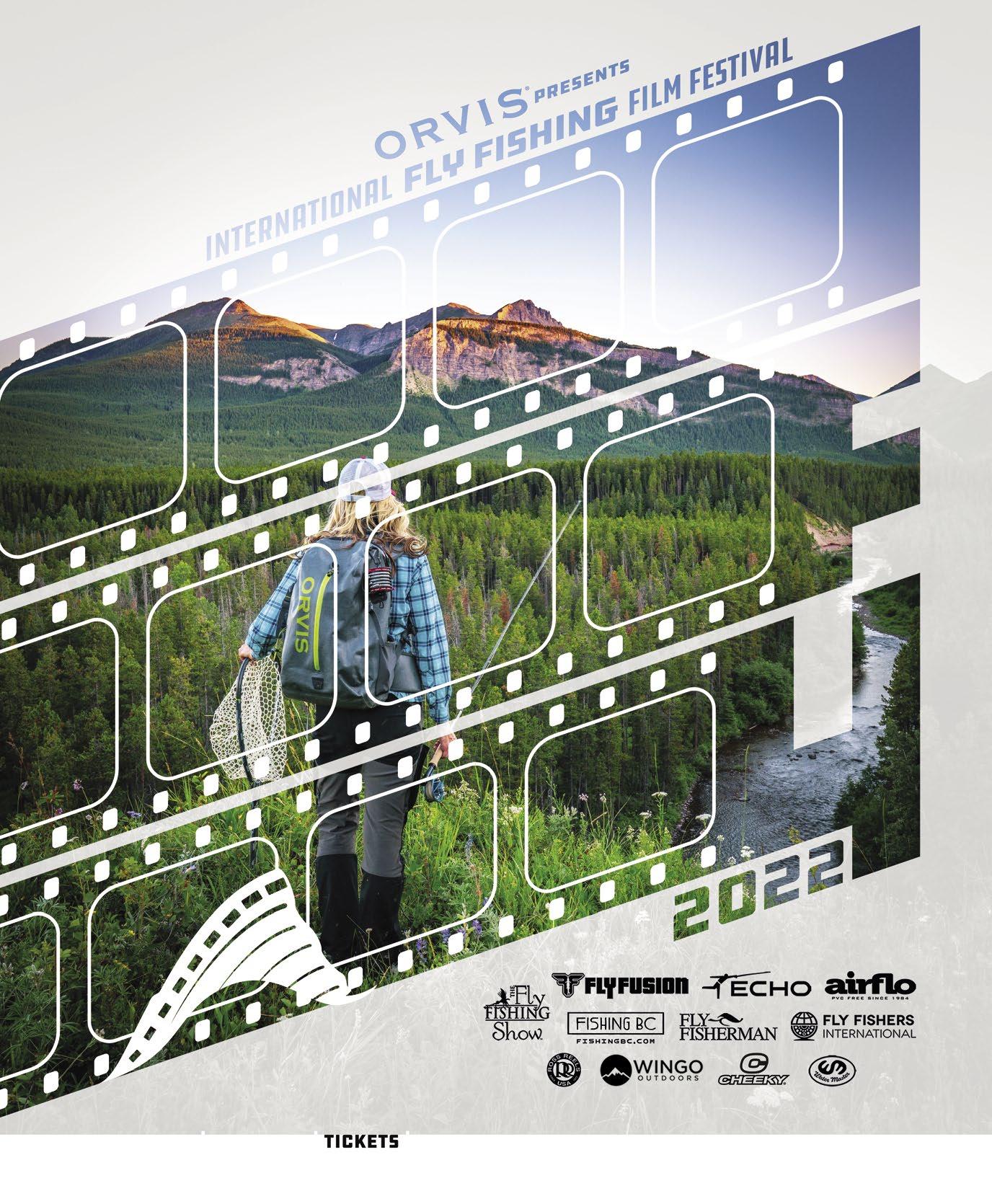


Board of Directors
Dave Peterson
Chairman of the Board
Patrick Berry (Non-Voting) President and CEO
Tilda Evans Secretary Awards Committee Chair
Jim Maus
Treasurer Finance Committee Chair
John Kirk (Non-Voting) Legal Counsel
Marnee Banks
Executive Committee Nominations, Elections, and Board Development Committee Vice Chair
Dutch Baughman
Executive Committee Education Committee Chair
Keith Groty Executive Committee Senior Advisor
Tom Logan Chairman of the BoardEmeritus Executive Committee Conservation Committee Chair
Richard Ross Executive Committee Nominations, Elections, and Board Development Committee Chair
Todd Heggestad Council Presidents Committee Chair
Patty Lueken Women Programs Chair
Kuni Masuda International Programs Chair
Berry Webster Membership Chair
Jonathan Walter (non-voting) Casting Programs Chair
Jerry Coviello & Jack Gillis (non-voting)
Fly Tying Program Chairs
Board Members
Kastine Coleman
Shalon Hastings
Chris Haunschild
Carole Katz
Geoff Mullins
Dennis O’Brien
Tim Papich
Andrew Reichardt
Berris Samples
Peter Vandergrift
Bruce Williams
Board Advisory Council
Len Zickler, Chair
Al Beatty
Gretchen Beatty Glenn Erikson
Fly Fishers International
1201 US Highway 10 West, Suite E Livingston, MT 59047 (406) 222-9369 flyfishersinternational.org
President and CEO
Lee & Joan Wulff Legacy Circle Patrick Berry | pberry@flyfishersinternational.org
Vice President of Operations
Conservation/Education Coordinator & Webmaster Rhonda Sellers | operations@flyfishersinternational.org
Communications Director Blake Parsons | blake@flyfishersinternational.org
Membership Coordinator
Presidents Club, 1000 Stewards Cole Hirschhorn | membership@flyfishersinternational.org
Clubs & Councils Coordinator & Fly Tying Group Jessica Atherton | clubs@flyfishersinternational.org
Casting Program Coordinator & Merchandise Nikki Loy | casting@flyfishersinternational.org
Membership & Donor Administrator Lindsey Webster | donations@flyfishersinternational.org
Bookkeeper
Sharon Cebulla | bookkeeper@flyfishersinternational.org
Flyfisher is the official publication of Fly Fishers International, published two times a year and distributed by mail and online free to members. Send membership inquiries, fees and change of address notices to the FFI Headquarters at the address listed above. Flyfisher is produced for FFI by Bird Marketing Group Inc.
Editorial & Advertising Inquiries: Editorial queries are welcome and should be sent to Bird Marketing Group Inc at the address listed above attention to the Editor. Email queries can also be emailed to bcovey@ flyfusionmag.com. Visit flyfishersinternational.org for the full writer and photographer guidelines.
Advertising inquiries can be directed to jbird@ birdmarketinggroup.com. Visit flyfishersinternational.org for Ad rates and spec guidelines.

Reprints & Permissions
All facts, opinions and statements appearing within this publication are those of the writers and are in no way to be construed as statements, positions, or endorsements. No part of this publication may be reproduced in any manner without the written consent of the publisher. Copyright 2022 Fly Fishers International.
Letters to the Editor
Send your comments about any aspect of Flyfisher to the Editor at editor@flyfishersinternational.org. We will endeavor to reply to each letter. We reserve the right to edit all submissions. Letters published in Flyfisher become the property of Fly Fishers International.
FlyFisher
FlyFisher is published for FFI by Bird Marketing Group Inc. PO Box 227A Eastport, ID 83826
Executive Publisher Jennifer Bird jbird@birdmarketinggroup.com Editor Bob Covey bcovey@flyfusionmag.com
Group Art Direction Terry Paulhus
Office Administrator Kim Carruthers
Department Contributors Conservation
Blake Parsons
Tom Logan Rick Williams Casting Jeff Wagner
Fly Tying Brian Shumaker
Feature Contributors
Grant Alvis
Eric and Andy Braker
Kate Fritz Andrew Reichardt
3
 Cover and contents image credit: Eric and Andrew Braker
Cover and contents image credit: Eric and Andrew Braker


6 President’s Message It’s all home waters 8 Seven Fisheries in Seven Days A Chesapeake Bay Road Trip 18 Brackish water, clear solutions From science to conservation to fly fishing 24 All Fish, All Waters Angler Profile Andrew Reichardt 28 Respect Your Elders Fishing for Bowfin, an apex predator for the ages 34 Conservation Science on the Fly: Citizen science in action 38 Casting Reflections on mentorship 42 Fly Tying A satisfying shimmer 45 FFI Forum News, events and happenings 48 2023 Conservation Scholarships Empowering future conservation leaders 50 2023 Awards Honoring outstanding individuals and clubs 54 Fly Fishers International Clubs 5
Far flung or next door, it’s all home water
In mid-September of this year, the founder of iconic outdoor brand Patagonia gave the company away. After 49 years building a company culture inextricably identified with a commitment to conservation, Yvon Chouinard and his family divested of their ownership in Patagonia. Chouinard’s vision should surprise no one: all future profits will be used to combat climate change and protect undeveloped habitat around the globe. Now that’s leadership.
In 2020, the same company, Patagonia, launched an initiative dubbed “It’s All Home Water.” At the core of the campaign is a call to action with an eye towards conservation and restoration, as well as angler recruitment and opportunity. Count me among the believers, but the idiom “all home water” means even more.
You may live in British Columbia, but you should care about habitat protection in the Everglades. You may live on the Texas coast, but you should care about striped bass limits in the Northeast. You may live in the Rockies, but you should care about protection of the Boundary Waters. I could go on, but you get the idea.
To me, the idea that “it’s all home water” means that we should care about far-away places that offer fly fishing opportunities and represent our conservation values as though
they are in our backyard. As author and activist Bryant McGill noted:
There is a deep interconnectedness of all life on earth, from the tiniest organisms, to the largest ecosystems, and absolutely between each person.
And so we are all intimately linked in our commitment to conservation and each other. That’s a thread that helps tie together the broader community of Fly Fishers International (FFI).
FFI’s commitment to conservation and advocacy doesn’t start or stop with any single species of fish, habitat type, or political boundary. Our mission to foster the future and legacy of fly fishing extends to all fish in all waters.
In this issue, our journey reaches from the trout streams at the head of the Chesapeake watershed in Pennsylvania and Maryland, to the smallmouth bass in the Susquehanna,
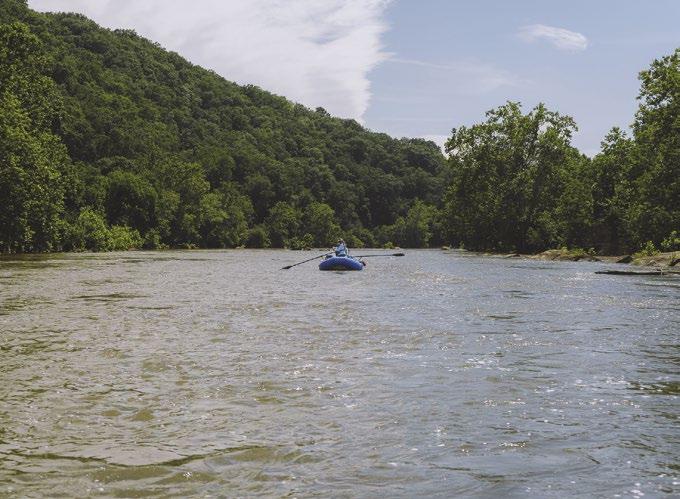
to the shad and bass in the Potomac, to the “rockfish” in the Bay itself, and to every other finned critter throughout the watershed. This is your Chesapeake Bay watershed.
These are your fish. These are your opportunities. And this is our responsibility to steward these precious resources accordingly.
If Yvon Chouinard can give away a $3 billion company in the name of climate change and conservation, we can do our part to support conservation initiatives in far-away places. We can pony up the small annual contribution to support organizations like FFI that represent our values and work tirelessly to ensure the legacy of fly fishing through conservation, education, and inspiring a growing community of fly fishers. In order to move the needle, it all has to be home water.
Patrick Berry
Patrick H. Berry is FFI President and CEO. Berry brings over 27 years of experience within the environmental conservation field, having come to FFI from the Vermont Community Foundation where he served as vice president of philanthropy. A former commissioner of the Vermont Fish & Wildlife Department, Berry is recognized as a visionary conservationist and is widely respected by his peers.

6 FlyFisher Fall/Winter 2022 PRESIDENT’S MESSAGE
Photo Eric and Andrew Braker
What’s your legacy?
What’s your legacy?
THE FFI
—
“It’s never too early to think about doing something significant for the sport I love. Leaving something to FFI now is a meaningful way to support the future of fly fishing.”
ANDREW
Join FFI’s Lee & Joan Wulff Legacy Circle and have a lasting impact on the sport that is about so much more than catching fish.
Join FFI’s Lee & Joan Wulff Legacy Circle and have a lasting impact on the sport that is about so much more than catching fish.
—
It’s never too early to think about doing something significant for the sport I love. Leaving something to FFI now is a meaningful way to support the future of fly fishing.”
“It’s never too late to make a significant impact on what I value most—I’m leaving 95% of my estate to FFI to ensure the legacy of fly fishing.”
It’s never too early to think about doing something significant for the sport I love. Leaving something to FFI now is a meaningful way to support the future of fly fishing.”


 — LARRY
— LARRY
“It’s never too late to make a significant impact on what I value most—I’m leaving 95% of my estate to FFI to ensure the legacy of fly fishing.”



“It’s never too late to make a significant impact on what I value most—I’m leaving 95% of my estate to FFI to ensure the legacy of fly fishing.”
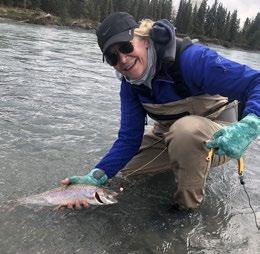


— LARRY
—
LARRY
“It’s never the wrong time to leave a legacy for future generations of fly fishers. I joined FFI’s Legacy Circle in the midst of significant life changes and couldn’t believe how easy it was to include FFI in my estate plans.”
“It’s never the wrong time to leave a legacy for future generations of fly fishers. I joined FFI’s Legacy Circle in the midst of significant life changes and couldn’t believe how easy it was to include FFI in my estate plans.”
“It’s never the wrong time to leave a legacy for future generations of fly fishers. I joined FFI’s Legacy Circle in the midst of significant life changes and couldn’t believe how easy it was to include FFI in my estate plans.”


 KIM
KIM
— KIM
— KIM
Now is the best time. How about you? At any age, any time, All fish, All waters.
Now is the best time. How about you? At any age, any time, All fish, All waters.
Now is the best time. How about you? At any age, any time, All fish, All waters.
In addition to leaving a bequest in your estate plans, you can also name FFI as a beneficiary of an IRA or 401K account. Contact President and CEO Patrick Berry to learn more at pberry@flyfishersinternational.org.
In addition to leaving a bequest in your estate plans, you can also name FFI as a beneficiary of an IRA or 401K account. Contact President and CEO Patrick Berry to learn more at pberry@flyfishersinternational.org.
In addition to leaving a bequest in your estate plans, you can also name FFI as a beneficiary of an IRA or 401K account. Contact President and CEO Patrick Berry to learn more at pberry@flyfishersinternational.org.
flyfishersinternational.org
THE FFI
on the sport that is about so much more than catching fish.

Seven Fisheries in Seven Days

A Chesapeake Bay Road Trip
Eric and Andrew Braker
During the Summer of 2022 the Braker Brothers (Andrew and Eric Braker) took on FFI’s challenge to go on the ultimate Chesapeake Bay Watershed road trip, covering more than 1,000 miles and seven fisheries in a week. This is their account of the adventure that followed.

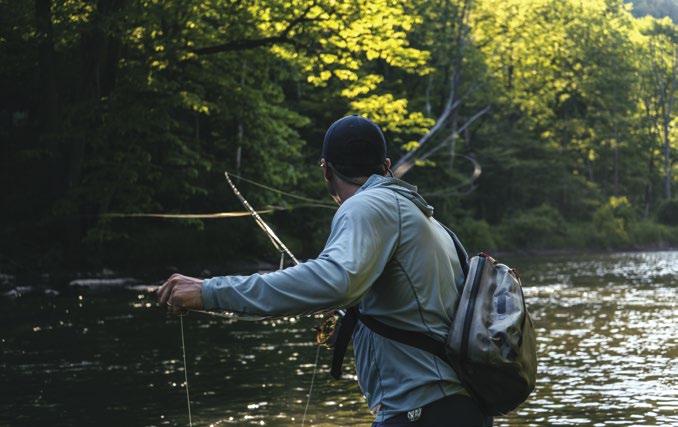

Growing up in Maryland, the Chesapeake Bay always inspired us. But as the watershed is so large and diverse, it seemed impossible to experience everything it has to offer. Between job commitments, maintaining relationships and navigating everything else life throws at you, being able to chisel out enough time to get to know the largest estuary in the United States often felt like a distant fantasy. However, when FFI reached out to us and conversations about raising awareness about the Bay’s diversity began in earnest, we knew that this was our opportunity to touch that distant dream. This was our moment to put life on hold, to fully embrace the ultimate Chesapeake adventure.
Day 1: From D.C. to drakes
The trip started in Washington D.C., where we met up with FFI’s Andrew Riechardt, got acquainted with the “green machine”—our home on wheels for the next week—and began
our journey north. Winding our way through the congested streets of D.C., we were preoccupied with our destination: a place with open spaces, spring-fed creeks and hatching green drakes.
By noon, we’d made it to central Pennsylvania, where we were greeted by the Alliance for the Chesapeake Bay crew. A number of their employees and board members, including CEO Kate Fritz, were on their annual central PA fly fishing trip with the hopes of timing it with a productive green drake hatch. It just so happened that we had the same thing in mind.
We spent the day fishing a stretch of river known to hold sizeable browns and for hosting a prolific drake hatch, and we interviewed Kate Fritz about the connection between agriculture, forests, bug life and trout. As the day continued, we observed a consistent presence of the mayflies that we were searching for, but we began to second guess if we were in the right spot to experience the pinnacle of the legendary hatch. As the sun began to set, we made a lastminute decision to jump down river, where the hatch had reportedly hit hard the previous night. Let’s just say that things worked out alright.
Andrew and Eric Braker
Andrew and Eric Braker are award-winning filmmakers who are on a mission to use the power of outdoor storytelling to spark sustainable change. Through outdoor filmmaking, content creation, and influencer marketing, the Braker Brothers love to work with like-minded brands to tackle projects that align with their mission.
10 FlyFisher Fall/Winter 2022
Day 2: Brookie bender
After an evening around the campfire and a restless night in the Green Machine, we brewed some coffee and hit the road. Thoughts of West Virginia’s rolling hills and colorful native brook trout (our favorite fish) filled our imaginations as we began our journey towards the Seneca Rocks area.
Soon we were greeted by Dustin Wichterman, Associate Director for Trout Unlimited’s (TU) Mid Atlantic Cold Water Habitat Program. We spoke with Dustin about the history of brook trout in the region and some of the projects that he and his team are working on to revitalize populations of large native brook trout. But there was only so much time for talk. Dustin graciously took us on the grand tour of the valley, an area that he knows like the back of his hand, and we fished every honey hole along the way.
Dustin knew the best spots to fish, in part, because in many cases they were on the very same sections of stream that, years ago, he had helped restore. He was familiar with
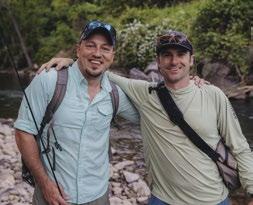
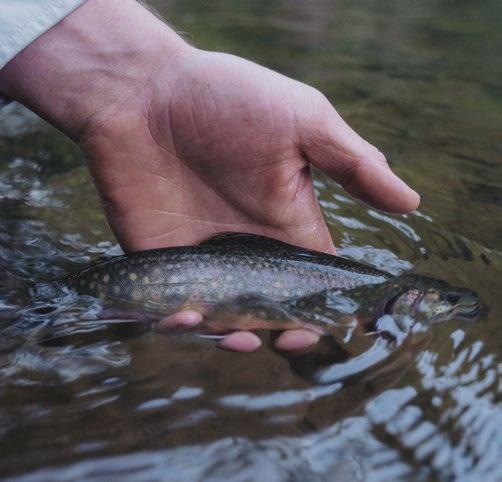
seemingly every single log, riffle and hydrological flow in each area. His passion was refreshing and inspiring. Spending time with someone who is so dedicated to restoring brook trout populations gave us hope for the future of our favorite species.
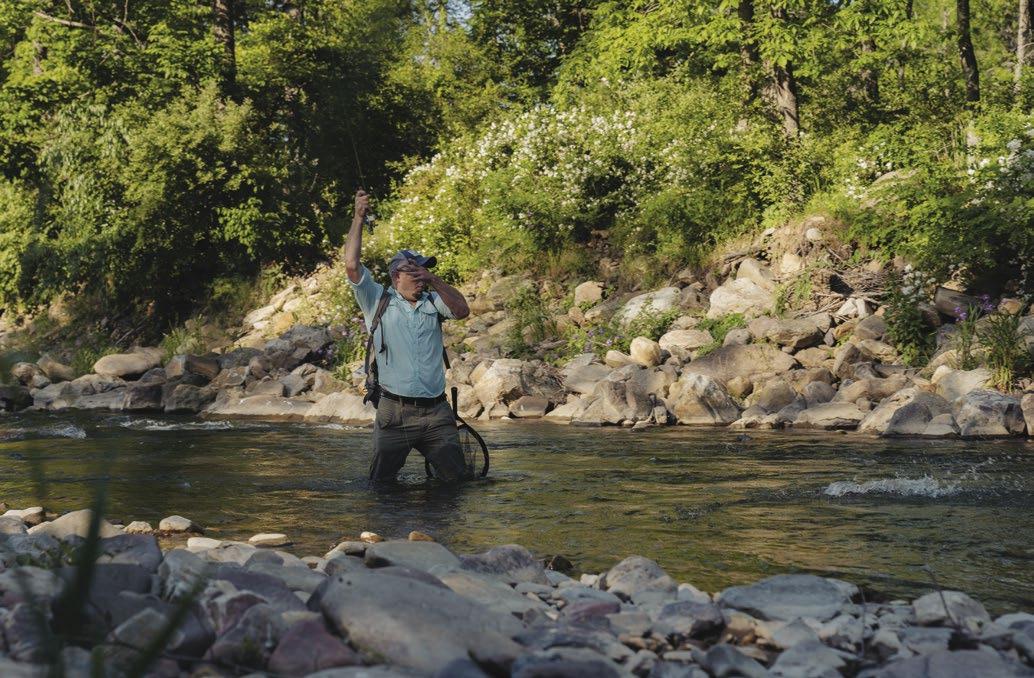
11 Seven Fisheries in Seven Days
Day 3: Changing on the fly

After sharing stories with Dustin late into the night, we woke up to unfavorable weather. The area we were hoping to find smallmouth bass was projected to receive rain and thunderstorms all day. As we packed up our things and begrudgingly began the journey back to D.C. for the night, we lucked into a weather window on a smallmouth river closer to home. Instead of throwing in the towel for the day, we decided that day three would be the perfect opportunity for an impromptu adventure in a new setting. Our spontaneity was rewarded. After catching a century of green sunfish, a few dozen smallmouth bass, and a handful of rockbass, all on topwater; after observing bald and golden eagles, wild turkeys, and kingfishers; and after witnessing spring-fed waterfalls and unique rocky outcrops, we could confidently say that this “throwaway” day was a major win. However, it was time to shift our attention once again.
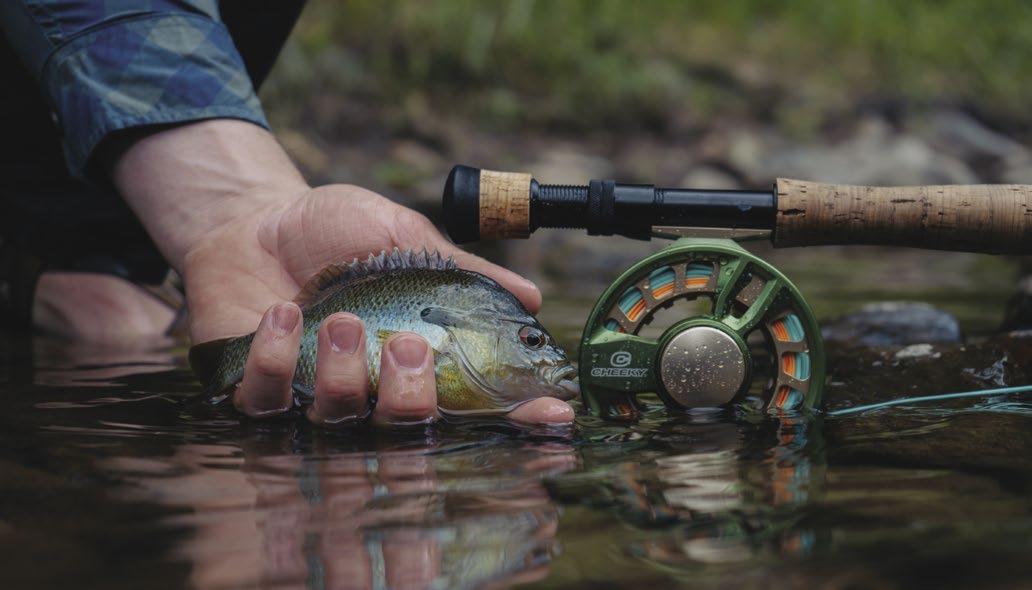
12 FlyFisher Fall/Winter 2022
Tomorrow we would be back in the nation’s capital, but this time we would be splashing boats in search of snakehead in a highly urbanized environment.
Day 4: Snake-bitten
Stuck in Friday morning rush hour traffic in northeast D.C., the contrast from the previous three days spent in the woods was enough to put us on edge. As we launched the boat from a trash-filled ramp, it dawned on us that this day would be much different than the idyllic float the day prior. But we weren’t just here to wax poetic about waterfalls and rainbows, we were here to learn. Our lesson began with Phong Trieu from the Anacostia Watershed Restoration Partnership (AWRP). We spent the day with Phong, checking out various sections of the Anacostia River, sight-fishing snakehead, and discussing some of the history, and hitches, which intertwine this complicated river. Being in the heart of DC, the Anacostia has battled with maintaining healthy water quality and equitable access for recreationalists. We learned that the work that AWRP is doing is putting this river on track for a healthy and accessible future.
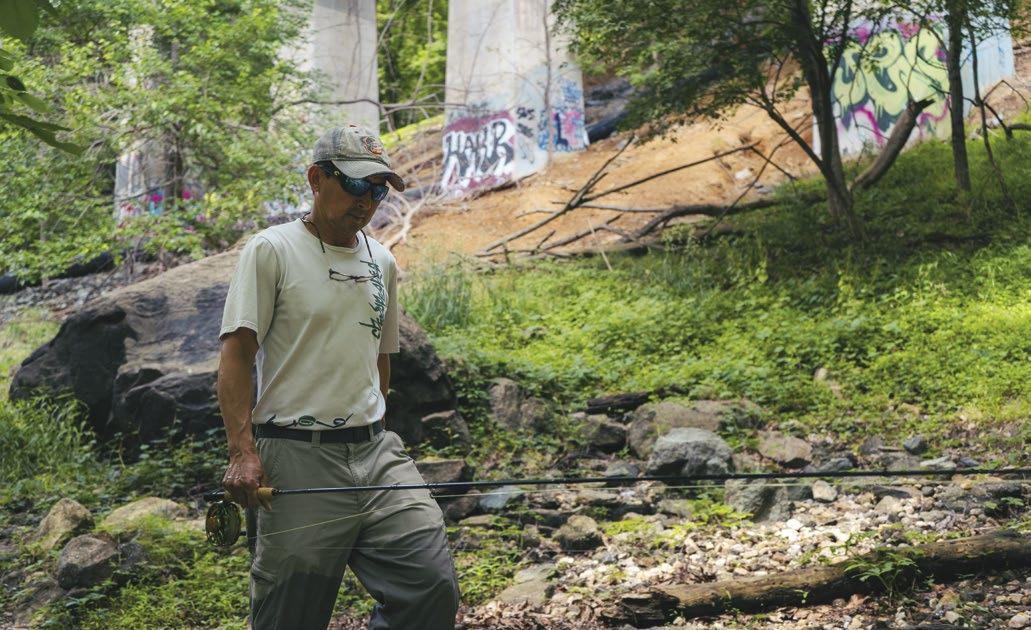
Due in part to an unseasonably cold spring, our timing proved to be less than optimal for targeting snakehead. We came across a few fish, but they seemed to be more interested in each other than the flies we were presenting. Humbled, and with a fresh skunking under our belt, we jumped back into the van ready for the next stage of the journey.
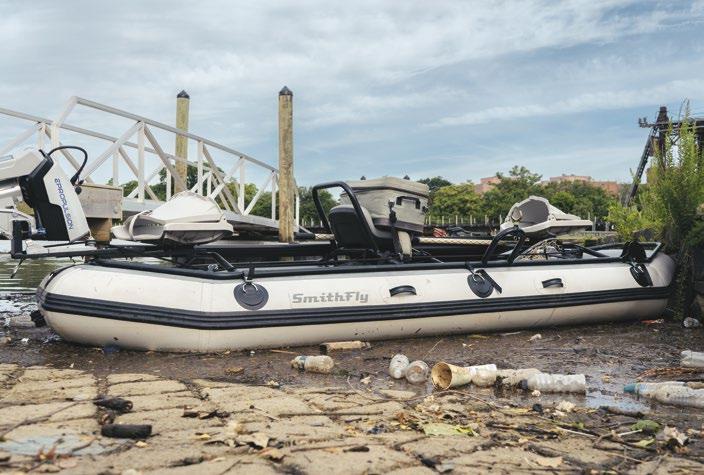
13 Seven Fisheries in Seven Days
Day 5: Polin’ for bowfin
The next morning the Green Machine was humming down Route 95 South, headed towards the swamps of Virginia. We had plans to meet up with bowfin angler-extraordinaire and Richmond-based guide, Grant Alvis. Grant is one of the fishiest dudes you’ll meet, and his passion for bowfin, one of the oldest surviving fish species on earth, is infectious.
We spent the day poling through swampy channels and sight-fishing this prehistoric species, but we came up empty handed. A couple of willing largemouth bass helped us keep our heads up, but failing to connect with the target species for two days in a row started to weigh on us. Did we bite off more than we could chew? Was seven fisheries in seven days too tall of a task?
While we pondered the question, we continued to fish our butts off, slotting enough time to interview Grant about the state of the bowfin fishery. Eventually, we packed up to

continue the journey—this time, we were headed towards the mouth of the bay. We were ready to smell the saltwater and to embrace the opportunities that the next day would bring.

14 FlyFisher Fall/Winter 2022
Day 6: Chasing cobia

In the morning we met up with Zack Hoisington, an environmental education teacher and fishing guide with Chesapeake Coastal Charters. Zack targets a number of different species as a guide on the Chesapeake, but on this particular day we were in search of cobia.
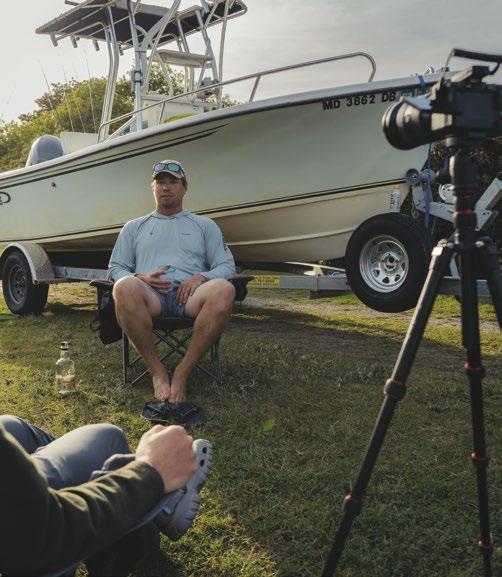

After a morning of cruising around the bay looking for these large fish (up to six-feet long and 100 pounds), Zack was able to connect with one. We soon learned how hard cobia fight! After a long battle, Zack coerced the giant into the net. It was well into the legal harvesting size, but considering that these fish are worth much more in the water than they are on a dinner plate, we revived the powerful fish and released it back into the water.
As an environmental educator and fishing guide, Zack is a firm believer that people need to have firsthand experience in the outdoors in order to learn more about it. He also believes that education leads to ambassadorship. Zack has found that teaching and guiding is a perfect way to facilitate that transaction—one student and one client at a time.
After managing to land the massive cobia, we celebrated over oysters and shrimp, reminiscing about the day and telling fish stories into the night. Tomorrow would be the last day of the trip, and although we were disheartened the adventure would soon be curtailing, we were excited to see what the morning would bring.
15 Seven Fisheries in Seven Days
Day 7: Stripes and solids
In search of Chesapeake Bay striper action, we woke up early and headed up the eastern shore. We met up with our good friend and recent addition to the Chesapeake guiding scene, Jonathan Bland. While Jonathan just recently got his guide certifications, he is by no means a newbie. Born in Solomons and currently residing in Annapolis, Jonathan lives and breathes fishing the Chesapeake. We knew we could count on him to help finish the trip strong.
It only felt right that the last day of fishing on the Chesapeake Bay road trip was dedicated to catching the Chesapeake’s most iconic species. Not only was the species special, the setting was unrivalled. Jonathan took us to untouched grass flats, sandy beaches and oyster bars. The environments’ raw beauty conjured up thoughts about what the Chesapeake would have looked like hundreds of years ago—not much different than what we were looking at, we figured.

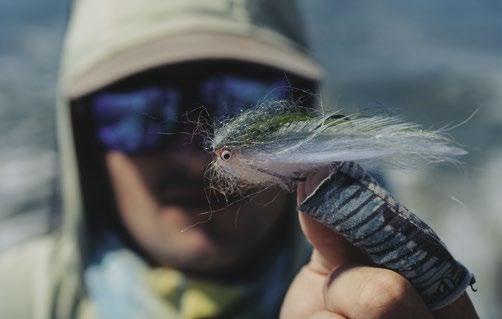
Jonathan has an important approach to his fishing and his general ethos. In order to maintain the diversity of these ecosystems and the fisheries within them, these amazing habitats and the Chesapeake as whole rely on healthy water quality. When Jonathan isn’t fishing or guiding, he is working to restore many of the tributaries within the Chesapeake Bay estuary. He has created a lifestyle balance of work and giving back to the watershed. He is able to restore headwater streams one day, then on the next outing, experience the main stem of the Chesapeake with his clients. It’s people like Jonathan who are going to fight for the sustainability of the striped bass fishery, and of the Chesapeake Bay as a whole.
Of course we wish we could have extended this trip out even further, spending more time in each fishery, and experiencing the many others that we reluctantly had to pass over. Eventually, work and life commitments come calling. The Chesapeake Bay watershed has so much to offer, that seeing it and fishing it in its entirety still feels like a fantasy, but if the Chesapeake Bay road trip taught us anything, it showed us this is a dream worth pursuing.
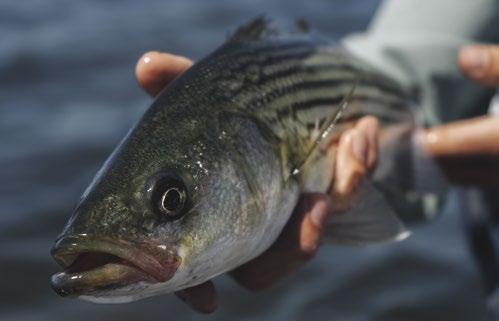
16 FlyFisher Fall/Winter 2022

 Photo Will Parson, Chesapeake Bay Program
Photo Will Parson, Chesapeake Bay Program
Brackish Water, Clear Solutions
Kate Fritz, CEO Alliance for the Chesapeake Bay

When you think of the Chesapeake Bay, I bet a few things come to mind: iconic blue crabs, traditional Old Bay seasoning, and rockfish. When I think of the Chesapeake, however, I think of more than 13 million acres of forests, 11,684 miles of shoreline, 3,600 types of plants and critters, 19 million residents (and counting) and an immeasurable local economic impact.
At 64,000 square miles, the Chesapeake Bay watershed is the largest estuary in the U.S. More than 150 major streams and rivers flow through the watershed, creating critical habitat for more than 348 species of fish. It’s also home to our nation’s capital, Washington, D.C., and some of the best American and Hickory shad runs on the east coast. Recognized as a “national treasure” under President Ronald Reagan, the restoration and recovery of the Chesapeake and all her miles of tributaries has been a priority for 50-plus years.
As the CEO of the Alliance for the Chesapeake Bay, and a newbie to the sport of fly fishing, I’ve learned more about the fish that inhabit our unique waterways in the last year than I have in the 18 years I’ve been working toward restoring
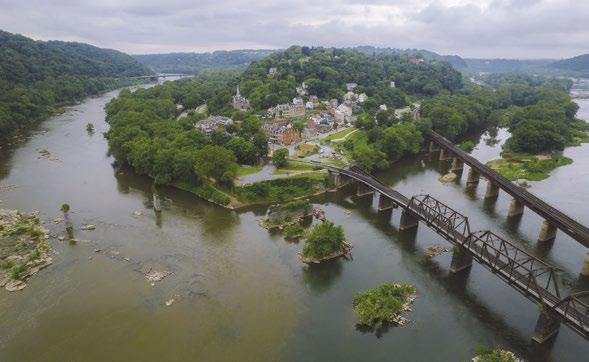
Kate Fritz
a resilient Chesapeake Bay watershed. With an academic background in biology piled on top of a penchant for leading teams that are passionate about clean and accessible water, these days, with a rod in my hand, I’ve found myself slowing down, observing streams, and asking a lot more questions. Is this a cold water stream? Was it once a cold water stream? What happened upstream to change the chemistry and biology of this reach? What kinds of bugs live here? Are there enough trees shading the water? My science background led me into a career in conservation, and conservation has led me to fly fishing.
Kate Fritz serves as the CEO of the Alliance for the Chesapeake Bay. Kate has lived in five of the seven jurisdictions of the Chesapeake Bay, and now calls Annapolis, MD home. When not standing in a stream, she’s working on making change at the intersection of land, water, and people. To learn more about the work of the Alliance, check out their website at www.AlliancefortheBay.org
19 Brackish
Clear Solutions
Photo Eric and Andrew Braker
Water,
Working Upstream
The Alliance for the Chesapeake Bay is one of many nonprofit groups which has, for the last five decades, been laser-focused on the restoration of our lands and waters. Our mission is simple: to bring together the 19 million residents of the watershed to restore our lands and waters. We work with constituency groups like neighbourhoods, international businesses, local governments and everyone in between. We believe that everyone can be a part of the solution in their everyday life; that thinking globally but acting locally is truly the only way forward for a restored Chesapeake Bay.
Our work consists of getting more boots on the ground to deliver cleaner water to our rivers and streams. We do this work out of offices in Maryland, Virginia, Pennsylvania and Washington D.C. by implementing solutions in four program areas, including: Forests, Green Infrastructure, Agriculture, and Stewardship and Engagement. Our work on the ground is driven by the needs of the landscape and the stakeholders who stand to benefit from this work. We know that what ails the Bay also ails our local waters.
Problem: Paving Paradise
If you’ve ever peeked into the woods behind your local strip mall, you’ll oftentimes notice corrugated metal pipes hanging out of streams. These pipes weren’t installed this way - they were originally placed on the bottom of the stream,
in order to convey water from one place to another. They now dangle like acrobats because of the feet of sediment that have eroded downstream thanks to the hot, polluted, and fast slugs of stormwater which sluice off of impervious surfaces upstream. Surfaces like roofs, road tops, and sidewalks prevent water from soaking into the ground and filtering slowly back to the nearest stream, and instead funnel gushes of summer storms directly into our stream banks like a fire hose. These periodic conditions negatively impact water quality and actively degrade fish habitat, often resulting in the washing out of in-stream structures, sediment in the water column impairing oxygen levels, and then subsequent sediment accumulation on the riffles and runs, smothering egg-laying habitat of freshwater-spawning Chesapeake Bay fish species.
Solution: Greening Our Infrastructure
The Chesapeake Bay has lost many ecosystems that help protect our waterways, and the Alliance has been working with local communities in D.C., Annapolis, Richmond, and Lancaster to build natural spaces back into our landscape. Instead of solely relying on grey infrastructure, such as curbs and gutters and traditional stormwater management ponds, green infrastructure enables us to build small ecosystems and functions back into our landscape. Features like rain gardens, conservation landscaping, permeable pavers and rain barrels all help to slow the water down, soak it in, and spread it out. As predictions of more severe and intense storms loom on the horizon, green infrastructure will become even more critical to how we develop our landscape.
Problem: Deforestation
The Chesapeake Bay watershed has been deforested twice. The first time was in the 1600s, when English colonists first came to Turtle Island and subsequently cleared the land for agriculture. Before the settlers arrived, the watershed was 95 percent forested. The second deforestation took place in the 1950s. A century prior, during the Industrial Revolution, the cleared fields were going fallow and retreating back to forests. The post-World War II housing boom ensured the catastrophic loss of trees along our Chesapeake streams, which in turn contributed to the loss of coldwater habitat— zero canopy for shade on a hot day, no leafy food sources for macro-invertebrates, no tree roots stabilizing stream banks, and frequent “flashy” times of flooding in-stream. With only 57 percent of the watershed still forested today, and the loss

20 FlyFisher Fall/Winter 2022
Photo Eric and Andrew Braker
of approximately 100 acres of forestland daily, the freshwater streams in the Chesapeake are critically threatened.
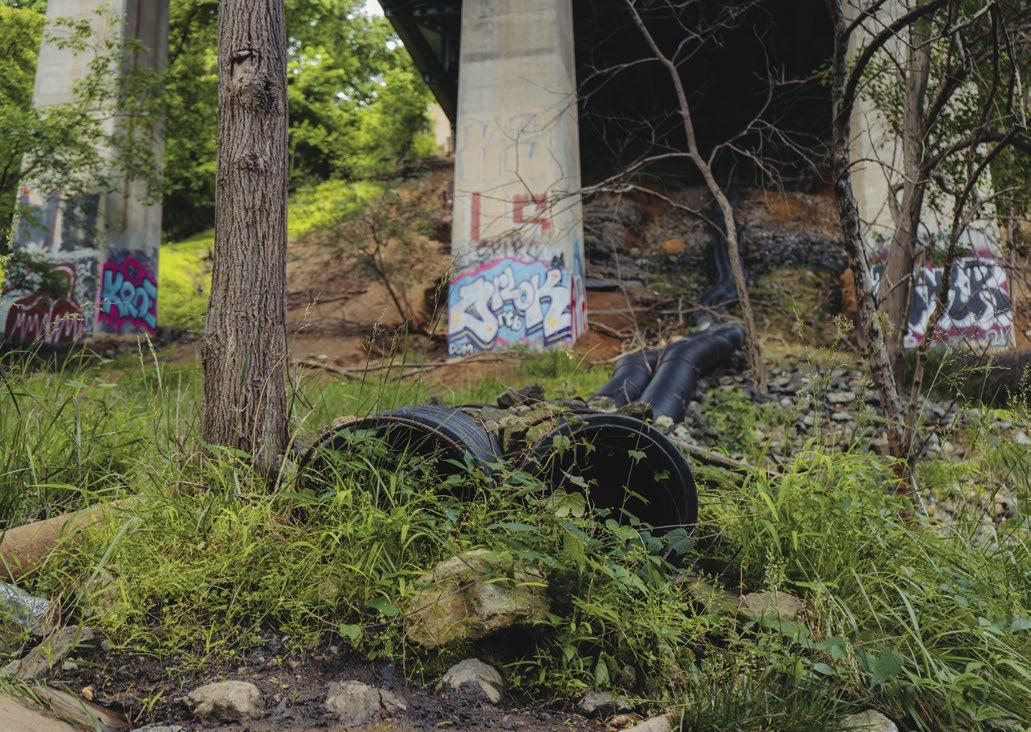
Solution: Forests for the Bay
One of the easiest, fastest, and cheapest way to restore the Chesapeake is through re-foresting our landscapes—at many scales. With approximately 80 percent of the forests of the Chesapeake held in private ownership, it becomes clear that in order to protect what we have and restore what we’ve lost, we need private landowners to step up to the plate. The Alliance works with landowners and communities across diverse landscapes and targets its tree-planting projects to those areas where they do the most good for water quality in the watershed—from stream side buffers to urban environments, and most places in between.
Oftentimes these landowners are interested in seeing their creeks and streams support a year-round trout population, something they want their children and grandchildren to enjoy into the future. The fish that inhabit a well-forested stream enjoy a multitude of benefits, including a canopy
casting shade to keep water cool, healthy insect populations, a network of roots to stabilize stream banks, and more consistent and regulated flows due to the natural filtration that trees provide. We say, “More trees, please!”
Problem: Too Much of a Good Thing
The watershed is actually made up more of land than water—an important piece of the restoration puzzle to know. As mentioned, the Chesapeake’s 14:1 land-to-water ratio, brackish quality and low flush rate in this shallow estuary means fertilizers and eroded sediments contribute to the continual decline of the Bay. When the Chesapeake cannot flush pollutants through the whole system, these extra nutrients contribute to algae blooms, which deplete the water column of oxygen and causes dangerous “Dead Zones” in the warm months. This lack of oxygen has big impacts on the migratory rockfish populations that need the Bay to spawn, and contributes negatively to overall health of the Chesapeake.
Fertilizers and manure contribute 40 percent of the
21
Clear Solutions
Photo Eric and Andrew Braker
Brackish Water,
nitrogen pollution to the Chesapeake, a statistic that has remained constant over the last five decades of monitoring. While it’s not a growing source of pollution, it is also not being reduced at a fast enough rate for restoration of our local waters. Because the watershed includes important agricultural assets like the Shenandoah Valley in Virginia, Maryland’s eastern shore and western fields, and central Pennsylvania’s high-quality soil, it’s important for our restoration work to consider the economic impacts to farmers and enable them to continue to produce food for a hungry citizenry.
Solution: Growing Sustainable Agriculture
In order to accelerate conservation efforts throughout the Chesapeake Bay watershed, the Alliance’s agriculture team works alongside partners in the agriculture supply chain, including farmers, cooperatives, and the corporations purchasing the product. Our approach allows farms to remain sustainable while elevating environmental standards
throughout the agricultural industry.
We are working with partners like Turkey Hill Dairy, The Hershey Company, Land O’Lakes, Organic Valley, Perdue, and others, to fundamentally change the system for how food is grown and produced in the Chesapeake Bay. By working within the supply chain, we are able to braid public and private resources and bring cost-share funding for farmers utilizing best-practices to supply these companies. Corporate partners are increasingly seeking ways to reduce their carbon and water footprints, and our work together helps everyone achieve the outcome of cleaner water through environmentally-responsible farming processes that don’t break the bank for farmers.
Problem: Losing Our Connection to Nature
One positive thing which came out of the COVID-19 pandemic is how many people reconnected with the great outdoors. But in this hectic world, that connection isn’t the norm—in general, as we log more screen time
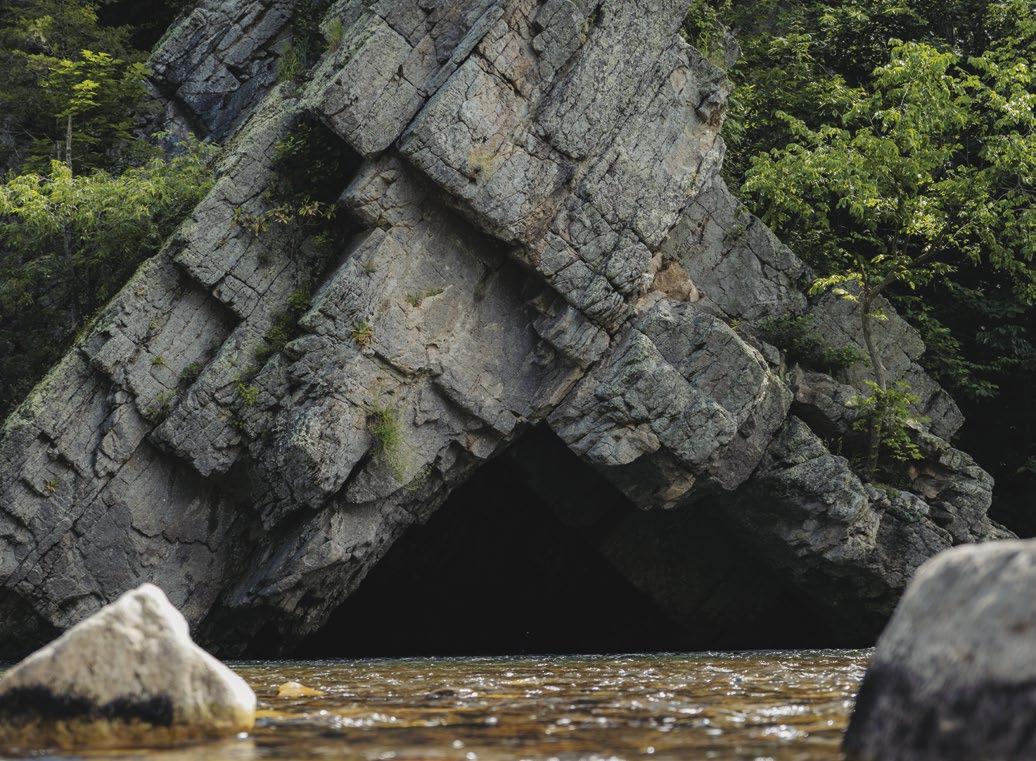
22 FlyFisher Fall/Winter 2022
Photo Eric and Andrew Braker
than ever, we are becoming more disconnected from the wilderness around us and suffer from the lack of meaningful relationships with our natural world. When we don’t access our natural resources, when we can’t observe them and feel them and recreate within them, it becomes more difficult to value their importance. Not only is getting outside an important part of anyone’s self-care routine, but the practice also creates more nature lovers and wilderness advocates. With the pending impacts of climate change challenges in the Chesapeake already knocking on our door, there is great urgency to continue to build awareness and engagement in these issues. The Chesapaeke is seeing local impacts of global sea levels rising, while our landform subsides—a perfect storm to drown our coastal wetlands and more frequently flood our roads, towns, and homes. Maryland’s capital, the City of Annapolis, at the heart of the Chesapeake, has seen the rate of “sunny day” flooding increase more than 925 percent since the 1960s, more than any other U.S. jurisdiction. With so much at stake, the Chesapeake Bay watershed needs all 19 million residents to be part of the solution for cleaner water.
Solution: Engaging a Community in the Watershed
We all live downstream of someone, and the Alliance works with our various communities, companies, local governments, farmers, and other stakeholder groups to educate people on that exact point. Through forums, conferences, events, and volunteer opportunities, we foster a deeper understanding and commitment to restoring our local lands, rivers, and streams. There are so many ways to engage people in this work, and the Alliance runs programs such as training community scientists to monitor the water quality of their local stream; building organizational and technical capacity of local watershed groups to do restoration work; and connecting stakeholders with resources to beautify their own communities. Everyone has an opportunity to positively impact their local watershed. Whether you’re reducing single use plastic with reusable water bottles and bringing your reusable bag to the grocery store, or gardening
with plants native and adapted to your region, we can all be part of the solution.

Anglers=Advocates
Since I picked-up a fly rod 18 months ago, many of my friends and colleagues have asked me to introduce them to fly fishing. As the sport becomes more accessible and inclusive to a greater diversification of people, it stands to be an incredible gateway for wilderness advocacy—as natural as accessing the rivers and streams of the Chesapeake Bay ought to be. In my far-ranging travels across the Chesapeake Bay, I have purchased fishing licenses everywhere I’ve gone and felt buoyed by the thought of a watershed loved, defended and supported by a wave of new anglers, their contributions and commitments helping promote conservation of the wild places we all should have the chance to explore.
The Chesapeake Bay is a watershed that contains myriad fisheries, from the famous brackish habitat of stripers, to the clear and cold native brook trout streams, to the openocean pelagic zones where cobia stalk squid, and every type of panfish habitat in between. These opportunities are what makes the Chesapeake Bay special for anglers, but even without a rod in-hand, Fly Fisher International readers will be able to recognize the watershed’s importance to more than 13 million acres of forests, 11,684 miles of shoreline and 3,600 types of plants and animals. The most important number, however, is the watershed’s 19 million residents. It’s from that population, after all, where the willingness to invest in the solutions to the Chesapeake Bay’s problems must come.
23
Solutions
Photo Eric and Andrew Braker
Brackish Water, Clear
Washington D.C.’s Andrew Reichardt has served in multiple leadership roles for FFI; has advocated on behalf of the organization with conservation and corporate partners such as Trout Unlimited and Orvis; and was one of the youngest TU chapter presidents in history, leading the National Capital Chapter of Trout Unlimited for four years, with the chapter nearly doubling in membership and seeing over a 500 percent increase in both volunteer participation and fundraising. Andrew is helping lead the Chesapeake Bay Watershed Campaign: From the Headwaters to the Bluewaters . A series of films connected to the campaign will help raise the profile of the Chesapeake and the fisheries within.
Bob Covey: Can you tell me how you first got into fly fishing? Do you remember your first fish on a fly rod?

Andrew Reichardt: Yeah. It was at three in the morning, my last semester of college. I was at a party and my friend asked me if I wanted to go fly fishing. I assumed he meant the next day, but an hour later we were standing directly next to the airport, fishing for striped bass. I’d never been fly fishing before, I didn’t know how to cast. And so I was just, kind of, just trying to chuck a Clouser Minnow out there. I didn’t know how to strip, so I was just swinging it. And then I ended up hooking into a fish, putting it on the reel, and reeling it in—which took forever. So that was both my first time fishing and somehow, miraculously, my first fish.

BC: That’s a good story! What was the last fish you caught? Where were you, who were you with and what did you catch it on?
AR: I was on the Potomac River somewhere near D.C., and I caught a smallmouth bass. On a wiggle minnow, on top water, in the evening. That was two weeks ago.
BC: Let’s talk about your campaign, and your efforts to raise awareness about Chesapeake Bay. How would you describe Chesapeake Bay? And, I guess, more importantly, what does it mean to you?
AR:. Chesapeake Bay is an incredibly diverse range of
24 FlyFisher Fall/Winter 2022 ALL FISH, ALL WATERS ANGLER PROFILE
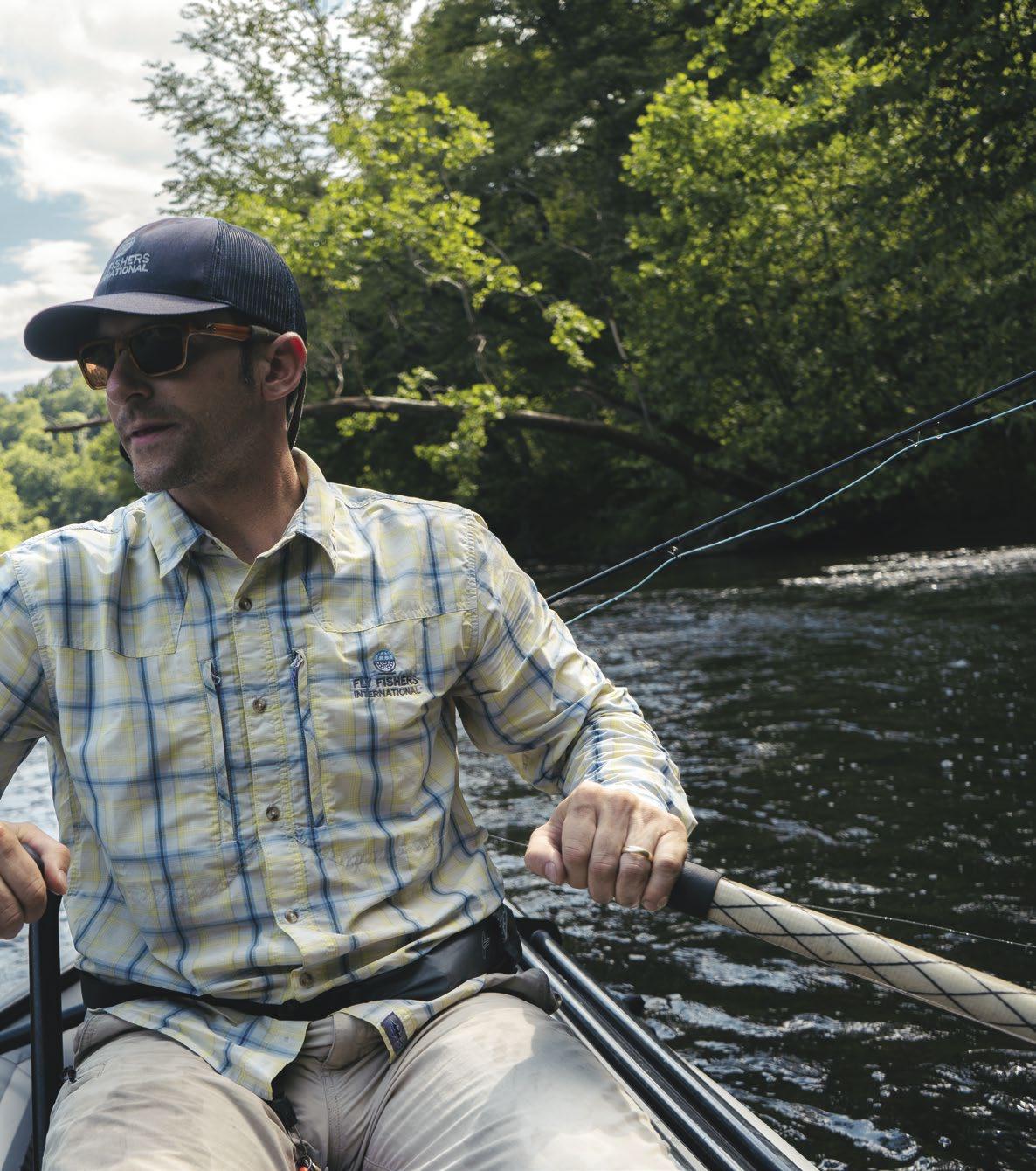
25
Photo Eric and Andrew Braker
All Fish, All Waters Angler Profile
geography, geology, habitat, ecosystems, fisheries and species. It is, I believe, one of, if not the greatest place to live as a fly angler in the world. There’s not a lot of places in the world where you can have western-style dry fly fishing for a native species—brook trout—and simultaneously, only three or four hours away, be able to sight fish to saltwater species that get over five feet long, like cobia. And you could do both in the same day, if you were really ambitious.
BC: I get the sense you are really ambitious. So we’re capturing the attention of anglers who are potential advocates, and wilderness defenders, what species are you most excited to fly fish for these days? Give me a snapshot of a great day fishing in your home waters.
AR: The species that I fish for most is smallmouth bass, which are a non-native species, but are available in every major river in the watershed. However the species that I enjoy fishing for most are bowfin. They’re one of the oldest fish species in the world. They’re air breathers, so they can live in very low dissolved-oxygen environments. They primarily live in tidal swamps with low salinity. They are the top of the food chain in the environment in which they live. They can be incredibly aggressive. You’re typically sightfishing to them. They can get quite large, over three feet long. And they just look mean and nasty, but beautiful at the same time. I describe them as a heavy metal fish.
BC: Wow, and what’s typically your setup for going after bowfin?
AR: Thirty-pounds floura bite-guard, and I’m either fishing a jerk changer, a changer craw, or—I don’t believe it even has a name—but it’s the biggest, heaviest crayfish pattern you’ve ever seen.
BC: That does sound heavy metal. That’s great. Let’s talk about some of the issues that the estuary is facing. I can discover through the Internet that there are problems with Chesapeake Bay’s water quality. I gathered from some quick research that polluted storm water, agricultural runoff, sea level rise, deforestation, development, all these things contribute to its problems. In the context of raising awareness among anglers, where do you start?
AR: I would start with the solution. And I would start with why we chose to do this campaign now. And that’s because in 2014 all of the major jurisdictions within the watershed—so New York State, Pennsylvania, Delaware, Maryland, West Virginia, and Virginia, as well as Washington, D.C. where I live—all entered into the Chesapeake Bay watershed agreement. That agreement sets down specific parameters of water quality
improvements that all of the states have to meet in order to restore the water quality of the Bay itself. The work includes everything from urban to suburban to ex-urban, and the rural environment, the rural areas, agriculture, soil conservation, livestock exclusion from streams, stream bedrock, stream channel restoration, wastewater and development impacts on streams. Those urban areas are there to stay. They’re not going anywhere, and so you have to make what changes and improvements you can in a relatively non-dynamic setting. So you’re really looking at how do you, in an urban environment, develop more groundwater retention, less runoff, less flashing? And less sewage. A huge problem in the major urban areas in the Chesapeake Bay watershed is that our civic infrastructure was built in the early 20th century and doesn’t have the carrying capacities required to support the populations that exist here today.
BC: That is fairly overwhelming. Is there a way for us to zoom in a bit, so readers can have a place to start thinking about the future of this area?
AR: I think we’re at a very hopeful moment in the Chesapeake Bay’s history. Because of that agreement, we have a range of players from the federal government, all of the state governments, the local jurisdictions, NGOs such as FFI, as well as private citizens, and even for-profit enterprises all taking actions, that, while each one may seem small, can have a large collective impact. For instance, a private citizen here in D.C. installing one rain barrel is not going to make a significant impact. But if you have hundreds of thousands of rain barrels, all of a sudden you do have a material impact on the watershed that you’re living in.
BC: I feel better already. You’ve had good success in reviving your local Trout Unlimited Chapter. For other people that might be faced with declining membership and interest in their local club, what was key for you in bridging the gap between, let’s call them “the old guard,” and new anglers?
AR: Patience and persistence. The ways in which young people, younger generations, and older generations communicate and think can be very different. But finding ways to convey common values and common ideas in ways that both sides can ultimately understand and agree upon is a huge part of it. The other thing is that, really, for grassroots organizations like TU or FFI, for the grassroots chapters, clubs and councils to succeed, it requires both generations really playing a role. Finding a way to utilize the energy and often the creativity of younger people with the experience, wisdom, and also, yeah, quite frankly, the
26 FlyFisher Fall/Winter 2022
time that empty nesters or retirees have is key. That’s really how you make this work. It takes those two groups, with some assist from families and young people in high school and college, and even younger people as well as their parents, but really, it’s those two demographics that make these groups click. Young people oftentimes want to change everything right away. That can be seen as disrespectful by people who’ve been there for decades, and really worked hard to build an organization. On the other hand, it takes open mindedness from the older guard. Just because somebody has a new idea, it doesn’t mean they’re necessarily being critical of what’s been done before. Sometimes new ideas and new blood can really transform an organization. But you have to give it a chance.
BC: Tell me about the message you hope the entries in the film festival tour will convey?
AR: They’re a celebration of the Chesapeake Bay watershed. I really meant it when I said I don’t believe there is anywhere better to live as a fly angler. The films are really going to shock people who aren’t familiar with this area, how much of an under-the-radar gem the Chesapeake Bay watershed is. It’s really that diversity of species that I think people will find really fascinating.

BC: What can the future hold for the Chesapeake Bay watershed? And who needs to be convinced to get it there?
AR: I think the future is still to be determined. It will never be restored to the state it was when John Smith sailed into the Chesapeake Bay and you could see through to the bottom, down 50, 60 feet, because the oyster populations were so massive that there was almost no suspended solids in the water at all. But it can be a lot better than what it is. That only happens if we, the general public, advocate for the resource. That means at the federal level all the way down to your local town council, asking what is all this water treatment? Where does our wastewater go? How is it treated? Are there small, outdated dams in our neighborhood?
At the local level is really where groups like FFI can affect things like small-scale dam removal, or identifying culverts that affect fish passage, but also act as barriers to sediment transport down the stream, for example. Those are smallscale projects, but once you add them all up they make a large-scale impact.
If the general public doesn’t advocate for the resource, the resource will not receive the care that it needs to be restored.
27
Profile
Photo Eric and Andrew Braker
All Fish, All Waters Angler
Respect Your Elders
Fishing for bowfin, an apex predator for the ages Grant Alvis
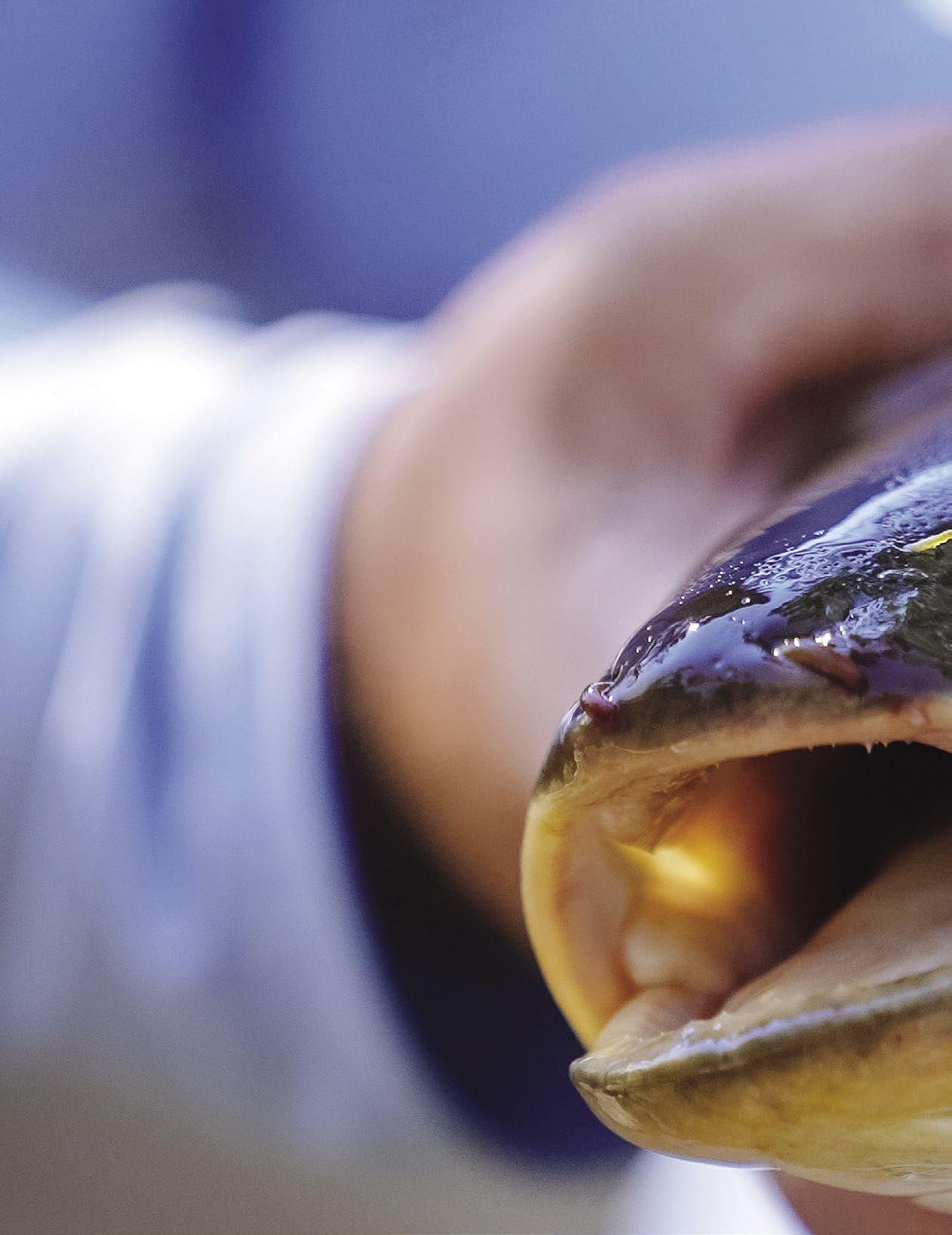 Photo Eric and Andrew Braker
Photo Eric and Andrew Braker

They go by many names: mudfish, dogfish, Cypress trout, choupique and grinnel. Regardless of what you call them, bowfin (Amia Calva) are one of the top predators in their ecosystem, no matter where they’re found.
A true living dinosaur, bowfin as a species have remained nearly unchanged for millions of years. And who could blame them? Why evolve when you’re already perfect?
The case for bowfin

Do you enjoy sight fishing? How about sight fishing to big fish? What about sight fishing to big, acrobatic fish that make vicious, repeated attacks on the fly? Fish whose fight doesn’t seem to have an off switch? Do you enjoy targeting native species that are still living in the same waters they’ve inhabited since before humans walked the earth? If you said yes to any of those questions, then bowfin might just be for you.
On average, bowfin are larger than most fish freshwater fly anglers typically target. Smaller bowfin hover around four pounds, while the larger fish commonly exceed double digits. Bowfin offer a unique opportunity for almost flatsstyle sight fishing, but in freshwater. Often laid-up on mud, next to downed trees or grass lines, bowfin’s natural camouflage adds to the challenge of targeting them and, for my money, makes the experience even more exciting. Spotting these fish strongly depends on water conditions and sunlight, and when one or both of those variables isn’t cooperating, the odds stack heavily in the bowfins’ favor. If you do have good water clarity, once spotted, the approach, cast, retrieve and hook-set must be executed expertly, with little room for error. The angler has to remember that these fish are a multi-million-year-old species. They didn’t survive that long by being easy to catch. Fishing for bowfin is all about the challenge; if they were easy to connect with, the experience wouldn’t be nearly as much fun.
Murky waters
Bowfin inhabit most of the eastern and mid-western United States. Typically synonymous with the Cypress swamps of the South Eastern U.S., most anglers don’t realize these
areas are but a small fraction of their native range. Bowfin typically prefer stagnant or slow-moving waters, and because they are bimodal breathers (they have the capacity to breathe both water and air), they can survive in extremely oxygen-poor environments. Bowfin are a predator species, so when fishing for them, you’ll do well to remember that small baitfish, crustaceans and amphibians make up the vast majority of the bowfin’s diet. Searching areas with high concentrations of these food sources is always a great place to start. Additionally, bowfin are almost always structureoriented. Wood and other hard structure‚ including docks and rocks, make up their primary habitat. In the absence of such structure, grass lines and drop-off edges of mud or sand flats offer great ambush points for predators and are great places to concentrate your search.
Bring the heat
Bowfin fishing is a warm weather affair. Typically bowfin become fairly dormant in the winter, only really feeding during warm spells and targeting small, slow-moving prey. Once the water climbs above the 60 degrees-Fahrenheit mark, the fish become far more active. Heat doesn’t put them off; bowfin seem to be most active during the warmest weather of the year and even in the middle of the day in 90 degree water they’ll eat surface patterns with reckless abandon.
Low tide, high vantage point
When targeting bowfin, the most important thing to remember is ambush points. Just like any other predator, the bowfin will use structure and cover to its advantage. Fishing flashy baitfish patterns close to cover, or dragging crayfish flies around rocks and wood structure, are great ways to locate these fish. If you’re fishing tidal water, lower tide or falling tides are always best. The falling water will funnel baitfish and crustaceans out of the shallows and into the waiting mouths of hungry bowfin. They are not unlike muskie in how they will often follow a fly all the way back to the rod tip— often multiple times.
While they are apex predators, bowfin are also very curious fish that will investigate anything new which enters
Grant Alvis
When Grant is not behind the wheel of a UPS truck he spends his days either on the bow or poling platform of his skiff targeting or introducing people to any number of the amazing fish his home waters of Virginia. From Bowfin to Brook Trout, Redfish to Snakeheads, Grant lives for the thrill of chasing anything that swims.
30 FlyFisher Fall/Winter 2022

31 Respect Your
Elders
Photo Eric and Andrew Braker
their environment. Sometimes brightly-colored or flashy flies can be a serious cheat code for bowfin, especially in dark or muddy waters where sight fishing isn’t an option. When sight fishing is an available technique, getting a look from a high-as-possible vantage point is advantageous. It may not sound like much, but getting your eyes even just 12 inches higher in the air can make the difference between spotting a fish at 10 feet or 10 yards. This vertical view can make or break the entire sight fishing experience.
Moody motions
When a fish is spotted, it is crucial to be able to diagnose the fish’s mood. This might sound nebulous, but bowfin have a tell-tale sign that will easily help you understand their state of being: their dorsal fin. The bowfin’s dorsal fin extends down the length of their body. When the fish is agitated, the dorsal slowly and methodically starts to undulate in a wavelike motion, down its back. Once you see it, you’ll recognize it. If the dorsal begins moving quickly, or there is a lot of
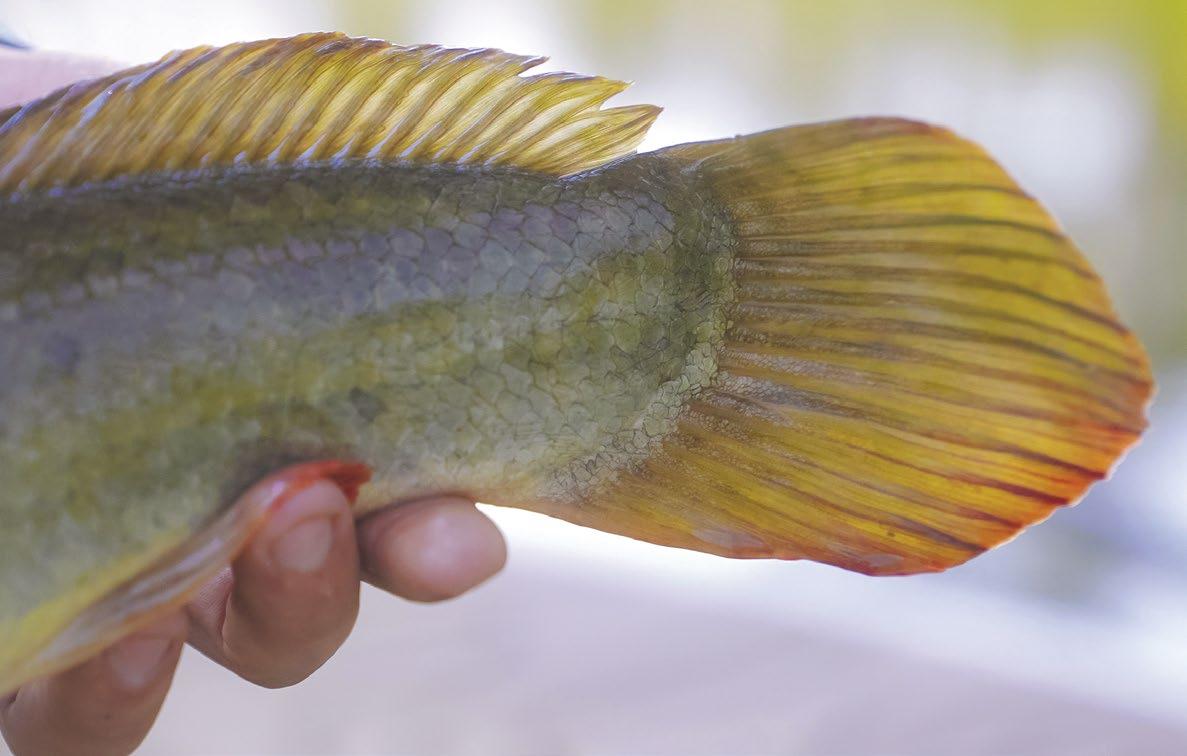
movement in the fish’s pectoral fins, it’s almost a guarantee that the fish knows you’re there and is unlikely to eat your fly. Interestingly, if the fish is sitting completely still, without any sign of agitation, it’s game time. When casting at a fish that’s laid-up, bottom-bouncing flies are the best strategy. Anything that resembles a crayfish will trigger bites when fished slowly past their face; and if the fish doesn’t attack on the first few casts, don’t give up. It’s not rare to make four or more casts at a laid-up fish before it decides to bite. Even dragging a fly directly across the fish’s nose can trigger a violent take.
Tackle tips
Powerful fish require powerful tackle. An 8-weight, fastaction rod will cover most bowfin applications, however, fly casters not used to throwing heavier or larger flies might consider bumping up to a 9-weight, just to make casting easier. The fly line is another very important part of the bowfin arsenal—depending on location, the climate-style
32 FlyFisher Fall/Winter 2022
Photo Eric and Andrew Braker
of your fly line can make or break a bowfin trip. In the southern U.S., tropical lines are necessary to combat the sweltering summer heat, whereas in the bowfin’s northern reaches, a more common warm water fly line will do fine. The reason it’s important to pay attention to the climatestyle of your line is so that your casting doesn’t suffer. Lines meant for cooler climates will become soft and often sticky in hot weather, making casting nearly impossible. A short, powerful, tapered fly line is perfect for bowfin angling. The line’s shorter head will allow for quick loading of the rod and facilitate accurate casting at close range. The powerful lines will also help carry wind-resistant and heavy flies to their target with ease. Leaders for bowfin fishing don’t need to be anything fancy. A two-foot butt section of 30-lb monofilament with six-to-seven feet of 20-lb monofilament or fluorocarbon as “tippet” is perfectly serviceable. Due to its lack of stretch, as well as its abrasion resistance, fluorocarbon makes a great bowfin leader. The lack of stretch helps with the difficult hookset into near-solid, bony mouths and the abrasion-resistance helps avoid bite-offs from the bowfin’s razor sharp teeth. In my experience, wire tippet is overkill and tends to decrease the number of takes.
The least important part of your outfit when targeting bowfin on the fly is the reel. While these fish are very powerful, they rarely make long runs; it’s unusual to be relying on your backing. They will, however, spray water 10 feet into the air, jump clear out of the water and dive under the boat. That being said, to aid in picking up line, as well as helping prevent kinks and twists, a large arbor reel is always a nice piece of equipment to have.
Simple pleasures
Your selection of bowfin flies need not be extensive. A small variety of baitfish patterns, surface baitfish (or frog imitations) and crayfish flies will cover 95 percent of all bowfin circumstances. Three-to-five-inch baitfish patterns, such as Game Changers, Murdich Minnows and larger Wooly Buggers are usually enough to pique the interest of a bowfin. Typically, baitfish patterns work best for cruising fish or for fish tucked into wind-blown bays, stucture or sandbars. In my experience, crayfish imitations are your best option for sight-fishing. Game Changer Craws, CK Clawdads and Nearnuff Crayfish are great options when you’re lucky enough to see a bowfin laid-up in a fishable location. If you’re really into chasing that adrenaline rush, you may want to give topwater bowfin a try. They will often
come up and inspect poppers, diving frogs and sliders. Occasionally they will explode on the fly like a muskie and other times they will follow the fly for 10 feet or more before sipping it off the surface like a trout.
Get a grip
My recommended gear list for targeting bowfin contains only a few things that most fly anglers may not already have in their quiver. One such item is a BogaGrip, or any other similar catch-and-release facilitating gripping tool, so long as it has the ability to swivel. Bowfin are tough fish and can create jaw pressure that would impress a crocodile. A gripping tool allows the angler the ability to securely hold the fish, and it helps relax the bowfin’s jaws, which will give the angler a chance to retrieve the fly, should it not be easily reachable. The other critical piece of bowfin gear is a net with rubberized-nylon. Solid rubber mesh nets can work, however, if a bowfin starts to roll violently—which they often do—there is the danger of the fish getting wrapped up tightly and breaking the rubber mesh. Rubberized nylon, on the other hand, can take a beating and is still gentle on the fish. Another, more common piece of essential equipment for targeting bowfin are polarized glasses with either greenmirror, amber or copper lenses to cut the glare in most freshwater environments. While I’m at it I might as well add in stripping guards. The hookset to connect these fish to the fly is a hard strip-set, combined with a rod lift. Particularly with the new textured fly lines in use today, that hard stripset can take a toll on your fingers. Stripping guards will protect your fingers and they also help keep slime from accumulating on fly lines.
All due respect
Bowfin are a formidable opponent for even the most seasoned fly anglers. Whether its the bone-jarring eats or the eye-crossing hooksets required to get the hook to penetrate, these fish will test your patience as well as your tackle. Anglers looking to sight fish for a powerful, acrobatic, heavy-hitting native species need not travel all over the country to do so. It’s time to take advantage of one of the most exciting gamefish in America that is likely right in your backyard. Whatever you call them—mudfish, dogfish, Cypress trout, choupique or grinnel—put a little respect on the bowfin’s name. They’ve been the apex predator in their environs for millennia for a reason.
33 Respect Your Elders
Citizen Science On The Fly

Addressing climate impacts on home waters
Adaunting but important task is being tackled by a collaboration of researchers, a Colorado-based outdoor products company, and a
network of citizen scientists.
In a time of changing climate, a partnership called Science on the Fly is having an important impact on waters across the country.
Founded as a collaboration of the Woodwell Climate Research Foundation— a leader in climate change science—and industry innovator, Fishpond, Science on the Fly began in
 Blake Parsons
Blake Parsons is Communications Director at Fly Fishers International. He’s rarely far from a fly rod, having escaped a career in advertising to make the rounds as fly shop guy and guide. Blake lives in Nashville, Tennessee with his wife Ally, who out fishes him on a regular basis.
Blake Parsons
Blake Parsons is Communications Director at Fly Fishers International. He’s rarely far from a fly rod, having escaped a career in advertising to make the rounds as fly shop guy and guide. Blake lives in Nashville, Tennessee with his wife Ally, who out fishes him on a regular basis.
34 FlyFisher Fall/Winter 2022 CONSERVATION
Blake Parsons
Photo John Land Le Coq
2019 with a handful of water sampling sites near Telluride, Colorado. Since then, the organization has expanded to more than 345 sampling site locations, both across the country and internationally.
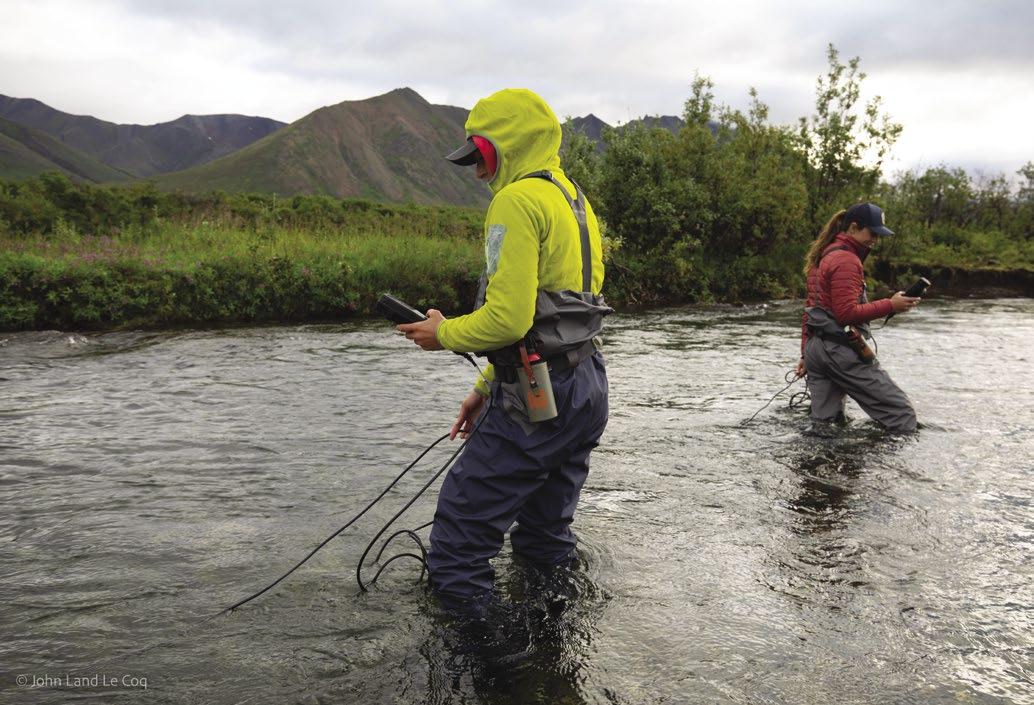
Since climate change first entered the conservation forefront, Woodwell has been working to communicate the insights of climate change to global decision makers. Woodwell was founded in 1985 as Woods Hole Research Center by ecologist Dr. George Woodwell. Meantime, John Land Le Coq, Founder and CEO of Fishpond and Member of the Woodwell Board of Directors, has long-leveraged Fishpond’s industry position to build support for fisheries and habitat conservation.
Where these partner missions meet
is on the streams and waters, the very places which are the harbingers of climate change effects. They also happen to be the same places fly fishers use Fishpond’s products. Science on the Fly has utilized this strong foundation to expand the list of partners supporting the organization’s activities.
Enter Fly Fishers International, and its members and community who fly fish for All Fish, in All Waters across the country. Not just a pragmatic endeavor to create better fly fishing opportunities, the Science on the Fly collaboration has roots in the FFI’s long term commitment to mobilizing fly fishers in efforts to protect the fish—and their habitats—at the very core of the sport. Having supported programs ranging from striped bass
fishery management, restoration of wild steelhead and salmon spawning corridors, and safe fish handling techniques, a Science on the Fly collaboration to protect the “All Waters” portion of the FFI mission was a natural fit.
Tom Logan, Chair of the FFI Conservation Committee and Chair Emeritus of the FFI Board of Directors, emphasizes that this work is necessary right now.
“Its essential that conservation efforts of Fly Fishers International focus attention on the waters of the United States and around the world where the effects of a changing climate are most pronounced,” Logan said. “Health of these waters is fundamental to the fisheries and their habitats where our members
35 Citizen Science On The Fly
Photo John Land Le Coq
teach new fly fishers and preserve the legacy of fly fishing.”
Conservation grant connects members with monitoring
A conservation grant awarded by FFI to Science on the Fly will help procure important data on climate-affected watersheds.
The grant provides necessary funding for the laboratory analyses of the water samples that are collected monthly at 11 monitoring sites across the country. These samples are collected by FFI members at each site and sent to the Woodwell Climate Research Center laboratory.
These FFI members will also install water temperature-monitoring devices which will provide scientific data on each of these new rivers, throughout the year—true citizen science and monitoring partnerships that Allie Cunningham, Science on the Fly
Director, sees as opportunities to raise awareness of the impacts of climate change.
“Science on the Fly’s partnership with FFI is beneficial because it allows us to expand our sampling on more freshwater rivers around the country while also allowing us to connect and educate more passionate anglers,” Cunningham said.

Streamside volunteerism
The grant affords a unique opportunity for FFI members who are participating in the study to play an on-theground role in demonstrating FFI’s commitment to conservation of fish and their habitats.
Mac Brown of Bryson City, NC is collecting samples on the Tuckaseegee River. Brown hopes to provide data that educates others, he said. His home waters were at one time one of the most polluted rivers in the country.


“It has recovered and is an
important trout fishery for economic impact,” Brown said. “It is my hope that Science on the Fly data will help educate folks of the reality of climate change and demand action for future generations.”
Like Brown, volunteer Craig Porter wants to build a data set that provides a picture of changes happening for his home. Porter lives in the California’s Eastern Sierra. Science on the Fly had data for other waters in the area, but not a local creek—McGee Creek, which
36 FlyFisher Fall/Winter 2022
Craig Porter California McGee Creek
CALIFORNIA
Gary Strawn California San Diego River
Photo John Land Le Coq
flows into the Owens River.
“I wanted to collect data to complete the area,” Porter said.





To facilitate the citizen science, Science on the Fly provides all necessary sampling materials.
“It’s pretty fun,” Porter said. That attitude is helpful in the demanding and ever-changing landscape of climate science. In the future, local watershed ambassadors will be key in having boots on the ground to produce the data that
organizations like Science on the Fly and Woodwell Climate Research Foundation rely on. In that way, the streamside volunteerism by FFI members such as Brown and Porter will, at some point not-tofar downstream, help influence the global climate discussion.

With more than three million river and stream miles lacing together the United States, it seems a daunting task to monitor, catalog, and analyze these watersheds with the goal of
preserving water quality. But that’s exactly the goal for Science on the Fly, and through a network supported by citizen scientists, the group is having an important impact on waters across the country.
For more information on Science on the Fly visit, scienceonthefly. org. To learn more about Fly Fishers International’s conservation actions, visit flyfishersinternational.org/ conservation/overview.
37 Citizen Science On The Fly CONSERVATION
TEXAS
FLORIDA
NORTH CAROLINA
NEW YORK
Tom Logan Florida St. Marks and Wacissa Rivers
Sam Decker New York Neversink River
Mac Brown North Carolina Tuckaseegee River
Jacob & Amanda Sherwood Texas San Gabriel River
Gulf of Mexico
The Gift of Guidance
Reflections on mentorship
Jeff Wagner
The last two years have reminded me of the unimportance of fly fishing.
With a generation-defining pandemic, it really does seem like getting out on the water should be the least of our concerns. Indeed, to an outsider, the pursuit of fly fishing might seem selfish; a self-serving, inconsiderate, privileged desire. The time spent, the money frittered away… for what? To release all the fish we catch? To go through a process that doesn’t even culminate in sustenance? In times of global upheaval, reflecting on why we fly fish has the potential of ushering in an existential crisis.
On the flip side, the last 30 months have also pointed out just how important fly fishing can be. For one, the past-time reminds us how blessed we are to have pursuits of pure enjoyment. We know that fly fishing can bring people together, provide common ground for opposing interests, drive economies and inspire art. It helps us commune with nature in a way that creates an appreciation for life and the longevity of the planet. Fly
fishing can facilitate the search, in a climate-affected environment, for more sustainable, harmonious solutions.
Like so many things, fly fishing is neither good nor bad in and of itself. What matters is what we do with it. While fly fishing is a valuable tool to teach about our natural world and share conservation, it’s my opinion that it’s even more critical as a vehicle to spending time with one another.
Casting aside preconceptions
Do you have someone in your life who you consider a mentor? A mentor doesn’t have to be a coach, teacher or advisor. A mentor could be a person at work who has demonstrated an interest in you and your development. It could be someone at church who has interest in your growth and discipleship. Or, it could be a fellow angler, a person who took the time to teach you about not just the river but the world around, using the common ground of catching a fish on a fly to help share the joys and challenges of life.
Yet being a mentor doesn’t
necessarily come natural to everyone. Here are some things I’ve learned about playing the role of trusted advisor.
Share sparingly
It’s normal to want to give advice, to talk and share. But sometimes, a mentor really needs to listen. I admit that for me, this is often the greatest challenge of being the best mentor I can be. I like to empathize through story telling and sharing my own experiences, but sometimes, that method has a limiting impact. I’m learning to ask a question, listen, and share sparingly.
Ask, then ask again
It’s easy to take offence when we extend an invitation to go fishing and the offer is spurred. When our intentions are authentic, hearing “no thanks” can be jarring. My advice to mentors is to stick with it, and don’t take it personally. I can remember in my early 20s being asked to fish several times by people who I held in high esteem. For reasons known only to my developing brain at the time, I declined the offers, multiple
Jeff Wagner
When he’s not fishing or casting you’ll find Jeff hiking or biking the back country with his family. They also volunteer their time to conservation efforts with groups such as Fly Fishers International. Oh, and during business hours Jeff does business stuff.

38 FlyFisher Fall/Winter 2022 CASTING

39 The Gift of Guidance
times, often to the same person. I suppose I was afraid of not knowing what I was doing, or feared being seen as an inexperienced kid. In hindsight I wish I would have said yes, but what has stuck with me for years is that I knew they cared enough to ask. Thank you Monte.
Show up and be present
Few things can leave more of a mark than a no-show from a mentor, coach or friend. Sure, life happens, plans change, but know your actions speak volumes. View the other person’s time as more important than your own.
Woody Allen said 80 per cent of life is showing up. If that’s true, then being present must account for the other 20 percent. I can relate. Attention-seeking interests and draws on our time are everywhere, from the alluring devices in our pockets to the following day’s commitments. But people— particularly those we have a mentor/mentee relationship with—can tell if we are engaged, or if we’re sidetracked. We can’t catch fish with our flies out of the water, and we can’t establish a connection with our minds out of the present.
Teach with compassion
My wife teaches fifth grade. I see her pour over books on education theories and principles. She strives to learn new teaching techniques to help students engage. While these are great tools, what makes her a great teacher is not the books, but her ability to convey a message with compassion. Teaching can come though examples, explanations, and practical experience, but so long as it’s presented with compassion, care and interest in others, the content of the lessons are almost beside-the-point.
Be enthusiastic
Enthusiasm is infectious. One’s passion for something can be heard and felt. Although it’s sometimes much easier to say than do, when all else fails, have fun and enjoy the day. Life is too short to worry about weather, flies, or temporal matters. Focus on the long term and let the relationship and the memories endure past the simple trials.
Fly fishing plays a big role in my life, but in the big picture, I know that hooking fish, casting tight loops and experiencing nature are secondary to connecting with the people I care about. Fly fishing in and of itself may be unimportant in the grand scheme, but in a world turned on its head, using it as a tool to teach, learn and bring people together is eminently rewarding.

40 FlyFisher Fall/Winter 2022
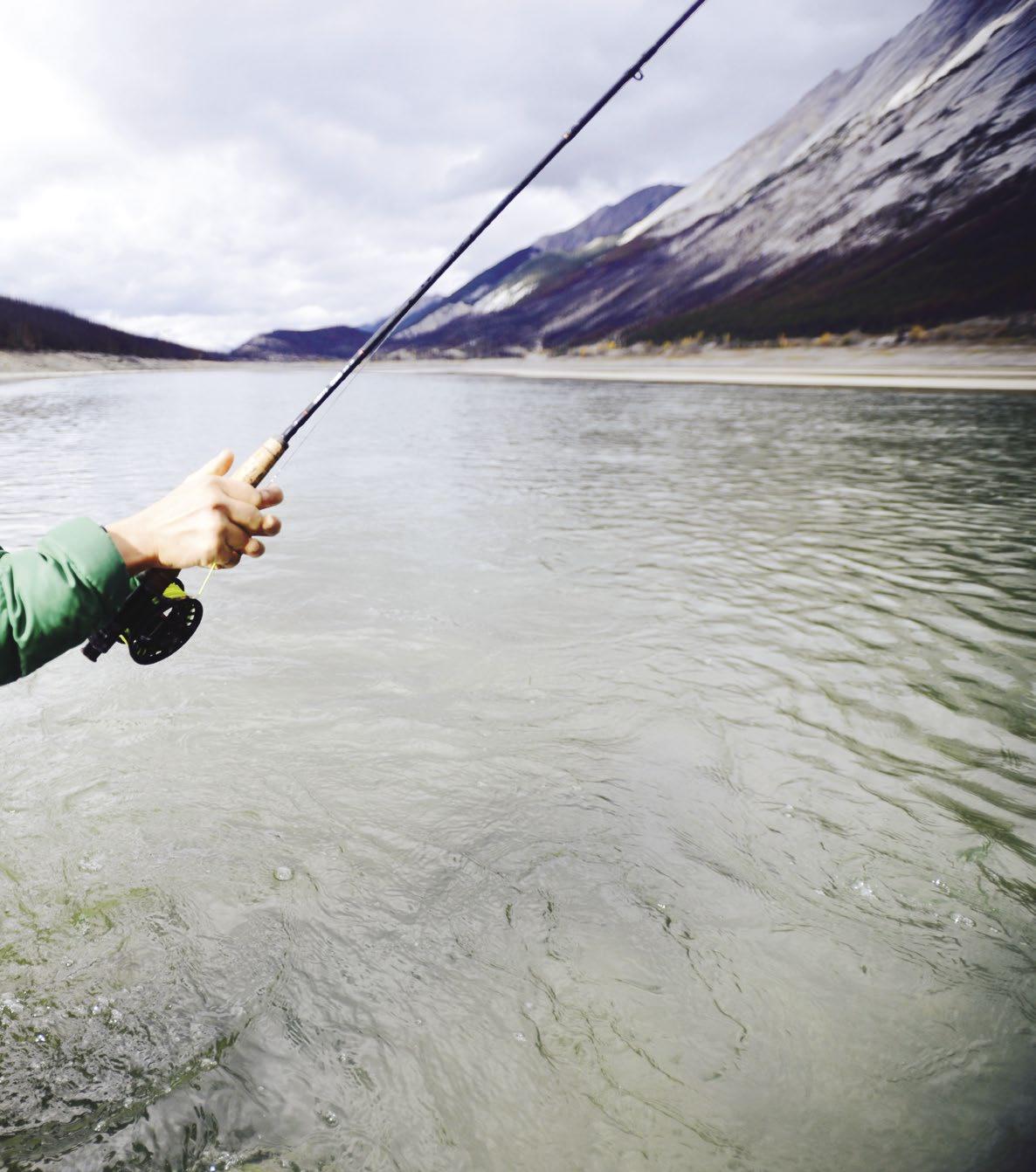
41 The Gift of Guidance
Photo Bob Covey
A Satisfying Shimmer
Brian Shumaker
The Shimmering Minnow is a pattern I developed to catch smallmouth bass somewhere around 2012.
I was looking for something that was quick to tie, something with which I could easily match the baitfish I found in the rivers that I fished. I have been guiding for smallmouth bass on the Susquehanna River for more than 20 years.

When I was developing this fly a decade ago, I wanted something that I could fish in the middle of the water column. Starting out, I experimented with a single hook. It worked well, the pattern caught fish, but there was something missing.
I started playing around with shanks. I started trying to add articulation to the fly. The hinged movement was key; all of a sudden, the Shimmering Minnow was catching a lot of fish. I was happy and so were my clients.
Then, while at a tying show one winter, I stumbled upon the the minnow’s missing link, so to speak. Flyman Fishing Company creates a
Fish Mask, a weightless, clear head that provides a clean alternative to creating heads with epoxies. It was the last piece of the puzzle. The Shimmering Minnow was complete. Well, nearly complete. Its best asset, in my view, is its versatility, and by coloring the fly with a marker—the color of which depends on which baitfish is common to the water that the angler is fishing—the possibilities are endless.
Don’t stop at markers, however. Get creative. Along with the different color combinations, one can size upthe Shimmering Minnow by adding shanks.
In that way, I suppose, The Shimmering Minnow is never quite complete. But then neither is the species list caught with one. The tally so far includes smallmouth bass, largemouth bass, trout, stripers, speckled trout, redfish, snook, and striped bass!
Here’s how I tie the Shimmering Minnow.
Klinkhammer
Special Material List
Fish Skull Articulated Fish: Spine 15mm Shank
Gamakatsu B1oS Size: 2 or FireHole 811 Competition Size: 4
Thread 6/0: White Strung Marabou White, Olive, Burnt Orange
Palmer Chenille Med Pearl
Fish Skull Fish: Mask #5
Fish Skull Living Eyes: Ice 3D Beads: White, Black, Gray, Light olive
Rio Powerflex Wire Bite: 20lb
Flashabou: Pearl, Sliver, Gold
Loon UV Clear Fly Finish Thick and Thin
UV light
Marker: Copic Warm Gray, Baby Blue, Spanish Olive
Brian Shumaker
Brian Shumaker is a smallmouth guide, author, fly designer and owner of Susquehanna River Guides specializing in fly fishing for smallmouth bass in south central Pennsylvania. You can contact Brian on the web at www.susqriverguides.com, or by email at susqriverguide@gmail.com and by calling at 717-574-5338.
42 FlyFisher Fall/Winter 2022 FLY TYING
Tying the Shimmering Minnow

Step 1. Place shank into vice and cover with thread
Step 2. Cut a piece of marabou 1 ½ inch long. Tie in marabou tail. Tail should be 1 3/8 inch long, add flash on top of tail, 3 strands of silver, 2 strands of pearl. Double over thread and tie down. Flash should be 1/8 inch longer than tail.
Step 3. Cut a 3 ¼ inch long piece of palmer chenille, tie in at base of tail with fibers facing toward tail and wrap forward to eye of shank leaving enough space to tie off. Tie off and whip finish.
Step 4. Using a marker, color only the top half of the palmer chenille.
Step 5. Cut a piece of wire 2 ¼ in long
Step 6. Place hook into vise and cover hook shank with a thread base.
Step 7. Place one end of the wire on top of the hook shank. Tie it down with the thread, ending at the end of hook shank.
Step 8. Slide the tail section onto wire. Take the end of the wire back onto the top of the hook shank. Pull the wire so its just touching the bend of the hook with the tail swinging freely.
Step 9. Attach a small amount of marabou on top of the hook shank, just enough to cover the bead.
Step 10. Cut a 5 inch piece of palmer chenille, attach it to the hook at the rear of the shank, with fibers facing toward the tail. Wrap to just behind hook eye, tie off and whip finish.
Step 11. Color the top half of palmer chenille with marker, matching the tail.
Step 12. Place a bead of UV Clear Fly Finish (Thick) around the palmer chenille behind the hook eye. Slide on Fish-Mask and cure with uv light.
Step 13. Apply eyes to Fish-Mask, apply UV Clear Fly Finish to each eye and cure with UV light.
Step 14. Fly is complete.
43 A Satisfying Shimmer
Rising to the Next Level: FFI’s New Strategic Plan
“If you don’t know where you’re going, you’ll end up somewhere else.”
Attributed to cultural icon and acknowledged master of malapropisms, Yogi Berra, this quote speaks wisely to the need to have a clear idea of where you are headed in order to make sure you achieve the results you intend. Organizations like FFI, with its many moving parts, require futurefocused strategic plans to grow and be successful.
In order to ensure that we collectively agree where FFI is going and how we are going to get there, the Board of Directors voted in April, 2021 to design and implement a strategic planning effort, addressing the changing environment in which we are now operating. Our goal was to identify key organizational priorities and develop action plans to address each priority.
The Board engaged the services of Jack Gillis of Ledge Strategic Planning to lead the Board as the plan was developed. Not only a renowned strategic planner, Jack has a deep knowledge of our sport as an experienced fly fisher and tyer, and, most importantly, an FFI member fiercely committed to our mission. When developing the scaffolding of the new plan, Jack reviewed FFI’s existing strategic plan, countless key documents and policies, the results of FFI’s comprehensive
member survey and conducted more than 65 interviews with key FFI stakeholders.
The plan says that “Over the next three years, FFI will reach new horizons by proactively focusing on three strategic initiatives including fundraising, communication, and leadership development.” The plan also includes strategic goals for education, conservation, fly tying, casting, women’s programs, membership, international programs, and development (fundraising).
A new mission, vision and revised core values serve as bedrock for the plan.
Mission
“The mission of Fly Fishers International is to foster the legacy of fly fishing for all fish in all waters through conservation, education, and inspiring a growing community of fly fishers.”
Vision
“Fly Fishers International will play a meaningful role in the global fly fishing community by collaborating with individuals, organizations, and industry leaders to have a positive influence on the evolution of the sport. FFI will accomplish this vision by building partnerships, increasing its membership, building financial support, and enhancing the impact of its programs.”
Shared Core Values
FFI is committed to preservation of fly fishing opportunities and the
“Legacy of Fly Fishing” for “All Fish, All Waters”.
FFI serves as the leading voice for fly fishing, its members, and the global fly fishing community.

FFI is driven by our Mission and Strategic Vision collaboratively at all levels of the organization including the Board of Directors, Operations, Councils, Clubs, members, and the fly fishing community.
FFI believes delivery of programs and value to members is essential to engaging them as active stakeholders in achievement of its mission.
FFI advocates that conservation of our natural landscapes is fundamental to our enjoyment of fly fishing, qualities of life and preservation of the “Legacy of Fly Fishing” and must be founded on the best available science.
FFI is committed to excellence in all areas of fly fishing education that includes conservation, fly casting, fly tying and fly fishing skills.
FFI believes that informed fly fishers become effective stewards of our natural resources.
FFI believes that collaboration and partnerships with other likeminded organizations, agencies and industries collectively provides a strong and more effective voice for conservation of natural landscapes and preservation of fly fishing opportunities around the world.
FFI believes that a diverse leadership and membership is essential to effective representation of the fly fishing community.
Dave Peterson
Dave is currently Chairman of the Board of Fly Fishers International. He is a semi-retired school superintendent who fly fishes as often as he can. The Pere Marquette River in Michigan is his home water and he also fishes regularly in Montana, Maine, Florida and the Turks and Caicos Islands. He has served as Chairman of the FFI Conservation Committee and is a Life Member of FFI. He is also Conservation Vice President for the Great Lakes Council of FFI and a dedicated member of the West Michigan Hacklers, his local FFI charter club.
CHAIRMAN’S
MESSAGE
44 FlyFisher Fall/Winter 2022
Three Key Strategic Initiatives
Fundraising: FFI will build a sustainable fundraising program to support core programs, new initiatives, and projects to continue to transform FFI into an increasingly relevant entity within the broader fly fishing community. Key elements of a robust and balanced development program include membership, annual giving, major giving, foundation support, and legacy giving through individual estate plans.
Communication: Strong communication supports all aspects of FFI by increasing the organization’s brand, reputation, and effectiveness. FFI’s strategic communications initiative encompasses four elements. Each element supports certain aspects of the organization; however, every element will be a factor in helping grow FFI and achieve our strategic goals. These elements include marketing, leveraging traditional and industry media, partnerships in
industry and messaging that recruits and retains donors.
Leadership Development: FFI will systematically identify and mentor emerging leaders; appoint vice chairs for each committee and leadership position to ensure effective leadership succession; continue to diversify the membership of the Board of Directors, and regularly evaluate the effectiveness of the Board of Directors.
Strategic Plans for Core Committees
FFI’s Core Committees include Education and Learning Center, Conservation, Women’s Programs, International Programs, Fly Tying Programs, Casting Programs, and the Development Committee.
While FFI has a number of other important committees (for example, Membership) the work of core committees is to deliver highly-valued programs, products and services to our members. To ensure collaboration
and communication throughout the organization, each committee will have its own carefully-designed strategic plan that will be coordinated with the three major initiatives.
Accountability through Annual Operational Plans
Too many strategic plans end up as bookends on a shelf and fail to come to fruition. In order to ensure accountability and continuous progress, FFI’s strategic execution process will be refined each year through Annual Operational Plans. These plans define what needs to be done, specify who is responsible and give a deadline for completion.
As we move forward to carry out this plan over the next three years, it is my sincere hope that you will see concrete results that increase FFI’s relevance and impact within the Fly Fishing Community. Join us as we create FFI’s future!
Tight Lines, Dave
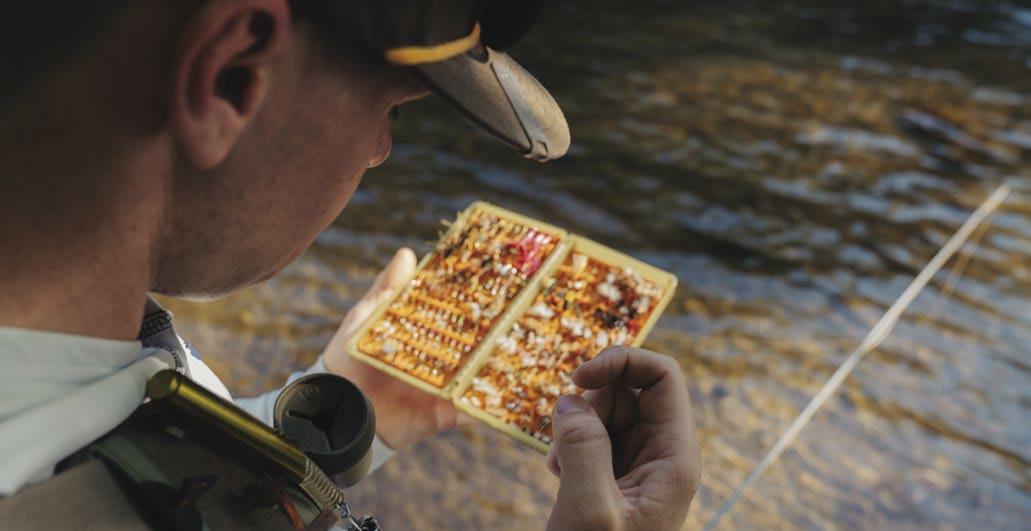
45 Chairman’s Message
FFI GCC announces 2023 Gulf Coast Fly Fishing Classic
The Gulf Coast Council (GCC) of Fly Fishers International will hold their Gulf Coast Fly Fishing Classic on Friday and Saturday, May 5-6, 2023, at the Gulf Shores State Park Learning Campus in Gulf Shores, Alabama. This family-friendly event is a celebration of fly fishing, fly tying, casting, education and conservation.
The event kicks off Friday morning with fly tying demonstrations by many of the region’s and some of the nation’s best fly tyers. Also on tap are presentations on local and global fishing opportunities, fly fishing techniques, and female-focused programming. Several of the nation’s top MCI and CIcertified instructors will be on hand, offering free basic instruction as well as fee-based advanced casting workshops.
The Classic culminates on Saturday evening with a showing of the 2023 Fly Fishing Film Tour.
Attendees to the Classic are automatically eligible to participate in the “Jubilee Challenge,” a free, mixedbag Catch Photograph Release (CPR)
contest where size doesn’t matter, but diversity does! Just a short walk away, Lake Shelby’s 1,000 acres are teeming with a wide variety of warm water and brackish species, while the nearby beaches harbor everything from pompano to tarpon.
Admission to the Classic is $10 for an entire family, good for the entire weekend. Some workshops require an extra fee. Tickets for the Fly Fishing Film Tour will be $25 each.
In addition, the Gulf Coast Council is highly honored to be hosting the FFI Board of Directors at this event, including Chairman Dave Peterson and

President and CEO Patrick Berry. At the Classic, the Board plans to hold their first in-person meeting since 2019.
“We’re looking forward to a great event,” says GCC President, A.J. Rosenbohm. “Interest is coming in from folks across the country. For us, it’s both an opportunity to grow our sport and showcase the wide array of fly fishing here on the northern Gulf Coast.”
For details and advanced registration (opens December 1), continue to check the GCC website at www.ffigcc.org
Chesapeake (PA-WV-VA-MD-DE)
Eastern Rocky Mtn (WY-CO-NM-AZ)
Eastern Waters (NY-NJ)
Florida
Great Lakes(MI-IN)
Gulf Coast (LA-MS-AL)
Northern California (CA-NV-HI)
North Eastern (VT-NH-ME-MA-RI-CT)
Ohio
Oregon
South Eastern (KY-TN-NC-SC-GA-AL)
Southern (NE-IA-KS-MO-IL-OK-AR)
Southwest (CA-NV)
Texas Upper Midwest (MN-WI-IL)
Washington (WA-AK)
Western Rocky Mtn (UT-ID-MT-ND-SD)
FFI FORUM
NH WA OR ID MT ND SD WY MN WI IA MO KS NE CO UT NV AZ NM TX OK AR TN IL IN KY MS AL GA SC NC NY PA RI DE NJ CT MD FL VT MI ME WV VA LA MI HI AK OH MA CA 46 FlyFisher Fall/Winter 2022
Re-rigging for the future: A fresh start for the SEC
Representing anglers in a 280,000 square-mile region is no small task, but the focus of the Southeastern Council (SEC) for 2022 is to foster fellowship among our community.
Encompassing the great states of Kentucky, Tennessee, North and South Carolina, Georgia and Alabama, the SEC has no shortage of waters, and anglers who comprise our community have no shortage of quarry to fish for— from delicate, native trout in mountain streams to powerful, willing redfish found in the saltwater of the Carolinas. Inspired by these angling opportunities and determined to reinvent itself after a COVID-caused dip in activity, the SEC’s 2022 council is forging a new path, led by former council treasurer Debra Pauli and supported by a strong team of directors.
We have much to build off of. There are more than 850 FFI members and 25 FFI clubs in the region, including the most-patronized clubs, the Carolina Fly Fishers Club and the Georgia Women Fly Fishers, both of which, as Charter Clubs, have more than 100 members. The Council’s challenge is to reflect
Council Presidents:
Chesapeake Lane Thurgood lthurgood68@gmail.com
Eastern Rocky Mountain Tim Papich president.ermc.ffi@gmail.com
Eastern Waters Sam Decker samfishes@hvc.rr.com
Florida David Olson david@whitestackle.com
Great Lakes Mark Johnson mjohns1588@outlook.com
Gulf Coast AJ Rosenbohm ajrosenbohm@gmail.com
the diversity and richness of our fisheries resources while serving and meeting the expectations of our community. Partnering on event organization with our clubs is one way that the SEC can maintain that sense of fraternity while gaining feedback from our members. In that vein, the newlyelected SEC has many planned events starting in the fall.
Thanks to the enthusiastic participation of our newly-formed Casting Advisory Board, casting events are scheduled in Alabama, Georgia, Tennessee and the Carolinas. Fishing the Waters of the SEC is a meetup series that will bring together our anglers to learn more about the vast fishing areas in our region, with the inaugural meetup being held in October in Cherokee, North Carolina. Featuring French Broad Fly Fishers as a co-sponsor, the on-the-water meet-up will begin with an online meet-up: participants will be invited to join area experts in a fun and educational Zoom meeting the week prior to get the lowdown on local tips, techniques and for an introduction to some of the area’s lesser-known fisheries. Over the next year we hope Fishing the Waters of the SEC will grow
North Eastern Jon Larrabee jon@larrabeereels.com
Northern California Mark Rockwell mrockwell1945@gmail.com
Ohio Jeff McElravy jmcelravysr@hotmail.com
Oregon Sherry Steele orcffi@gmail.com
Southeastern Debra Pauli president@secffi.org
Southern Chris Allen callenshooter@aol.com
as an event as we introduce anglers to new fishing opportunities and share our collective passion for the region.
For those who want to further their knowledge about the waters of the SEC, a companion program to the Fishing the Waters events is scheduled during FFI’s Virtual Expo. In it, a panel of guides and authors will share their knowledge of our region.
After a few false starts, we have finally been able to schedule our Fly Tyers Rendezvous. This event will be held in October in Cullowhee, North Carolina.
And finally, after a successful virtual meeting during Women’s Fishing Month, the Women Anglers of the SEC will continue to meet virtually—every quarter, it has been determined—to discuss all things fly fishing.
After a period of inactivity, the SEC is moving forward and our board is committed to bringing back the fun and sense of community that were once hallmarks of our council. We hope our membership will continue to grow and that new and established SEC members will let us know how we are doing in serving our community. To learn more, or to get involved, visit secffi.org.
Southwest Leigh Ann Swanson president@swcffi.org
Texas Rick Haness president@texascouncilffi.com
Upper Midwest Lyth Hartz president.umc.ffi@gmail.com
Washington State Steve Jones president@wscffi.org
Western Rocky Mountain Dave Londeree dlonderee@roadrunner.com
47 FFI Forum
Empowering Future Conservation Leaders
Senior Advisors – Conservation Rick Williams and Tom Logan
Conservation of natural landscapes around our globe is fundamental to preserving our opportunities to fly fish and the legacy of fly fishing. These lands, waters, and the diverse plant communities they support are essential habitats for fish and wildlife. These systems also process the clean air we breathe and the fresh water we use on a daily basis. We enjoy these natural landscapes in many ways – indeed, they are essential to our quality of life. This is where we fly fish, recreate with our friends and families, and seek renewal amid the solitude and beauty of these natural systems.
Fly Fishers International has been deeply rooted in conservation since its inception. FFI’s ongoing work promotes and reflects our members’ commitments to conservation, at both local and national/ international levels. Member surveys consistently remind us that FFI members share a common conservation philosophy and a deep willingness to support conservation projects and initiatives.
FFI Conservation Overview
Fly Fishers International is deeply engaged in a number of very
important projects that serve as a conservation voice for our members and the fly fishing community. We monitor dozens of conservation issues each year which have potential to either compromise natural landscapesor significantly enhance their enduring health and productivity as fish and wildlife habitat.We act on these matters by providing public comment or biological opinion, typically in collaboration with our many conservation partner organizations. This allows us to speak to agencies and policy makers as one strong and effective voice which represents millions of members and a multi-billion dollar per year recreational industry. This, and other conservation work we do, is guided by the bestavailable science and standardsset in the various environmental laws that are intended to protect our natural world.
FFI Conservation Grants Program
FFI also provides annual competitive Conservation Grants to FFI clubs and councils to fund on-the-ground conservation projects performed by our members in cooperation with state and federal agencies, or other environmental organizations. These local projects demonstrate Fly Fishers International’s practical application of the conservation principles we espouse, to improve local fisheries and fly fishing opportunities.
FFI Conservation Scholarships
The FFI Conservation Scholarship Program is an annual competitive
program that awards scholarships of up to $2,000 to college (undergraduate and graduate) students majoring in natural resource disciplines. The FFI Conservation Scholarship Program may be our most important conservation project, as these students will be the future scientists, administrators, managers and teachers of wild lands, fish, and wildlife management. By investing in our future leaders, the scholarships reflect FFI’s commitment to assure the future health of natural landscapes and that opportunities to fly fish endure.
Fly Fishers International is pleased to announce Conservation Scholarships for the 2022 Fall college semester to three exemplary students. All three are pursuing Master’s degrees across a range of fields, from stream restoration and conservation, to invasive species control and removal, to the use of geographical informatics systems for salmon conservation. All three hold values and research interests that are directly aligned with FFI conservation principles and policies.
Matt Deyoe is a graduate student at Montana State University who is preparing for a professional career in restoration and conservation of stream systems. He is a fly fisher who understands well the importance of healthy streams and rivers to his fly fishing experience. Matt is concerned that “The environmental damage due to mine drainage is negatively impacting the chemical, physical and biological integrity of the creeks across the world.” His graduate project intends to develop a “low-cost bioassessment”
48 FlyFisher Fall/Winter 2022
that will use macro-aquatic insect populations to assess stream health so that timely remedial actions may be implemented. Such work and commitment certainly is critical to an enduring legacy of fly fishing.
Wilson Xiong is a Master’s student at the University of Tennessee whose thesis research is
focused on testing the efficiency of physical removal of invasive species from streams to benefit recovery of habitats and native fisheries. This is a topic of significant concern to Fly Fishers International. Wilson plans to pursue a Doctoral degree in fisheries biology after obtaining his Master’s degree and plans to “become a professor or professional biologist conducting new research and supporting fisheries conservation”.
Ben Bagniewski is in the Master of Science program in Environmental Conservation at the University of Wisconsin. His graduate research is focused on the “use of geographic information science and remote sensing technologies to tackle environmental conservation issues like changes in land-use, forest
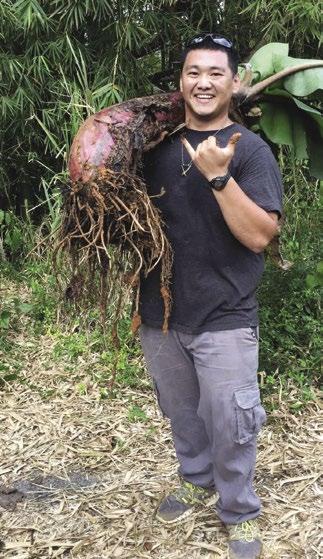

management, wildlife ecology and habitat conservation.” Ben’s goal is to apply the geospatial technologies to habitat and natural resource conservation and management on public lands across North America. He is a fly fisher and his primary concerns are that trout and salmon fisheries across the globe are at risk due to factors which include climate change, over-exploitation, commercial aquaculture, and competition with non-native species. His research is intended to develop a geospatial model which will allow agencies and other groups to identify upper reaches of watersheds that are in need of restoration to improve connectivity and habitat quality necessary to annual migration of spawning Pacific salmon and trout.

49 FFI FORUM FFI FORUM
FFI Award of Distinction for Leadership and Service
Al and Gretchen Beatty Boise, Idaho

For their generous contributions of time and expertise, for their dedication to making the sport more enjoyable and productive for other anglers and fly tyers, and for a lifetime of teaching and leadership in innumerable capacities, the 2022 FFI Award of Distinction for Leadership and Service is presented to Boise, Idaho’s Al and Gretchen Beatty.
The daughter of a commercial tyer, Gretchen Beatty learned to tie at age 10, using scissors, tweezers and a modified treadle sewing machine—no bobbins, no whip finishes, no frills. From that unconventional beginning, Gretchen progressed to become one of the definitive tyers of the last 25plus years. Beginning her career as and English teacher, then switching course to rise through the ranks in management at General Telephone, Gretchen’s skills were honed perfectly to facilitate her next career move: fly fisher, commercial tyer, business owner and teacher. Her leadership was critical to the success of the nascent Women Connect program, and she has continued to promote fly fishing, fly tying and teaching in all aspects of her angling life and career.
Al Beatty sold his first fly at age 14 to the local hardware store after learning to tie through his boy scout troop. When Al was in Vietnam in 1968, to supply an officer that wanted to fish the Mekong River, he tied flies using hooks and fishing line from his survival kit and locally-harvested
chicken feathers. No vise needed! More than 65 years later, Al is still commercially tying flies (although he does use a vise today!).
Al attended his first FFI Conclave in the early 80s. He rapidly became involved in the leadership of FFI while he and Gretchen built their fly fishing products business. With photography and video skills learned while serving his country and through his time in the telephone industry, Al took his knowledge-sharing to many mediums beyond print, the latest being the online video platform, Zoom. He was re-purposing copper from communications infrastructure to enhance his flies long before upcycling became a trend, and in 1993 served as Chair of FFI (with Gretchen contributing equally).
Between them, Gretchen and
Al have authored more than 800 magazine articles, more than 25 books and created more than 35 videos in the name of improving anglers’ outcomes. They’ve published more than 1,000 photographs and countless YouTube demonstration videos. This magazine has benefitted from their editorial talents over the years, and through international book and video sales, their passion and knowledge has been shared far beyond the United States. They were mainstays at the International Sportsman’s Expositions for 10 years, and fly tying fairs and fishing shows in the Netherlands, Denmark, Norway and England have benefitted from their demonstrations. Their fans are truly world-wide. Their accolades have come in many forms, from fan mail to fly tying awards (they’ve both been awarded the Buz
50 FlyFisher Fall/Winter 2022 AWARDS
Buszek Memorial Fly Tying Award).
In 2013 they were rewarded for their dedication to writing and teaching by receiving the Fly Tyer Magazine’s Lifetime Achievement Award for their “important contributions to fly tying, and making our time at the vise more enjoyable and productive.”
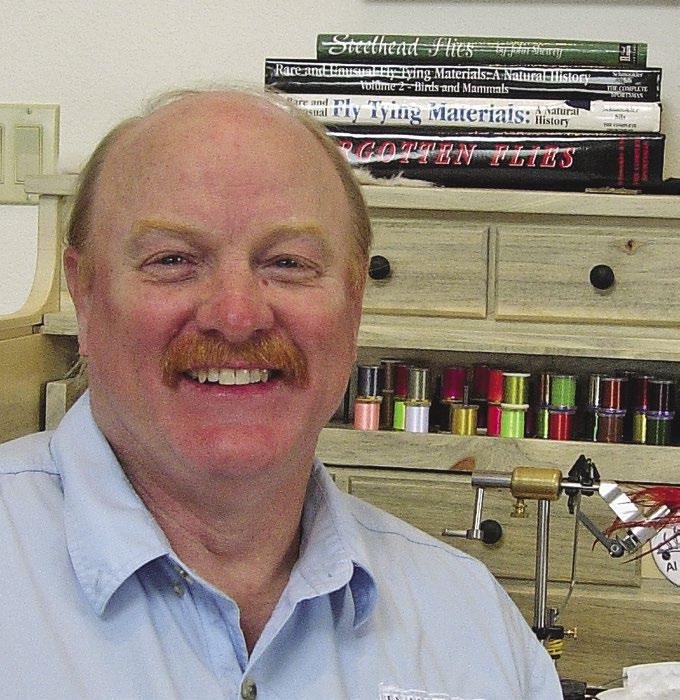
When it comes to contributing volunteer hours and expertise, there are no more generous individuals than the Beatty Team. If an auction or other fundraising item is needed, they are the first to donate, and many new tyers have an anecdote about Gretchen and Al supplying materials and tools to encourage an emergent hobby.
In the last two years, thanks to their willingness to embrace the Zoom platform, the Beatty Team’s profile has become even more renown. Their love for teaching has always extended to the sport’s ancillary applications: they authored an e-book on How to Write a Fly-Tying E-Book, and recently the Beatty Team have helped online learners get to know Zoom. They provided significant support for the 2021 Virtual Expo and several years ago, after earning the FFI Fly Tying Group’s Bronze, Silver and Gold Awards, Al and Gretchen went on to selflessly produce the videos that demonstrated how to properly tie their award-winning flies. They have both served as evaluators for the awards program and currently, Al, with supervision from Gretchen, serves as the second check-person for the program’s evaluators.
FFI benefits greatly from Gretchen’s and Al’s lifetime memberships. They use their tying skills to promote fly tying at conclaves throughout the organization, they served as the Fly Tying co-chairs for the FFF (now FFI)
for several years, and they also served a term on the Foundation Committee. Royalties from their book, Fly Pattern Encyclopedia, still flow to FFI. Before concentrating on tying, Gretchen facilitated a number of meetings for the Casting Certification Program during its developmental years. This included founding and co-editing their publication, The Tailing Loop, which is currently known as The Loop. Unsurprisingly, the Beattys also have a new book in the works.
Gretchen and Al have individually, and collectively, provided services and contributions to FFI that are extraordinary and significant. Those contributions continue today, including their service on the Board Advisory Council, the Fly Tying Group’s board and their work with the Women’s
Programs. FFI has represented a major focus for these two individuals for more than 30 years. Al and Gretchen are most deserving of the 2022 FFI Award of Distinction for Leadership and Service.
FFI Buz Buszek Memorial Fly Tying Award
Al Ritt Longmont, Colorado
Fifty years ago, at age 10, Al Ritt started fly tying with a Cabelas kit. His original mentor was Len Bearden, owner of the Millpond fly shop in Los Gatos, California. There Ritt tied with Sylvester Nemes, Dave Whitlock, George Anderson and others. After
51 Awards
he married, Al moved to Colorado and tied flies commercially. His home fly shop was St Vrain Anglers where he tied flies with Gary LaFontaine, Jack Dennis and others. Since that time, he has conducted fly tying demonstrations, presentations and classes for fly shops and clubs across the country as well as demonstrations and workshops for Expos throughout North America. In 2001 he was hired at St Vrain Angler where he was the instructor for intermediate fly tying classes.
In 2005, Al started a new business, Al Ritt Flies, where he taught fly tying classes and sold his proprietary flies. Al later started offering hosted, destination fly fishing trips and published his first book “25 Best Most Versatile Flies.” He has published many articles with the Fly Fishing and Tying Journal, Hatches Magazine, Fly Fisher, Fly Fusion and Fly Tyer. He also held positions of Fly Tying Field Editor for Fly Fishing and Tying Journal and Fly Tying Field Editor for Fly Fusion Magazine.
Al has been a member of TU since the early 1980s. He joined the Federation of Fly Fishers in 2008 and became a Life Member in 2009. He also joined the FFI Fly Tying Group as a Life Member in 2009. He began serving on the FFI FTG Board of Governors in 2010 and is still on the board. While serving on the board he was the Secretary, FTG Rendezvous Raffle Chairman and worked extensively on developing and implementing the FTG Tying Skills Award Program. He is currently on that committee, as well as the FTG Fly Tying Video Library
committee and Fly Tying Challenge committee. Al has completed the FTG Tying Skills Award Program Bronze, Silver and Gold Levels. He is also an evaluator and reviewer for this program.
Al is a most deserving recipient of the Buz Buszek Memorial Fly Tying Award
Fly Fisher of the Year Sandra Carpenter
Sandra Carpenter, best known as Sandy, embodies FFI in everything that she does.
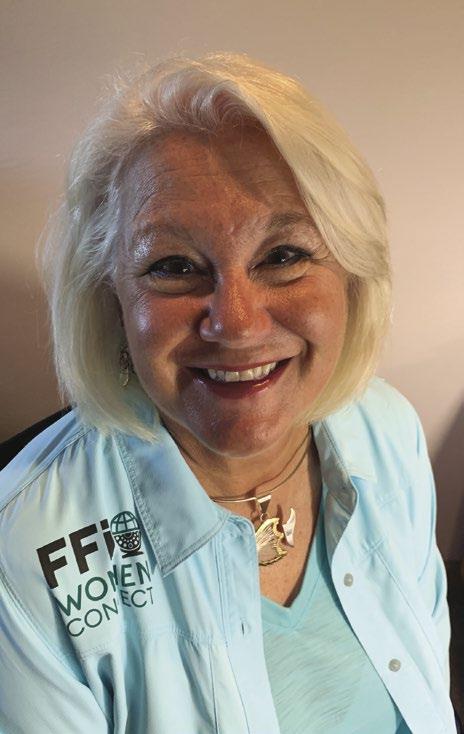
Sandy first came to FFI at an Expo in Livingston, taking classes to learn how to fly fish so she could join her
husband Mike on the water. Soon, Sandy was coordinating the Women Connect Program at the Expos and then continuing to help make the Women Connect Program into the FFI Women’s Program Committee.
Sandy’s devotion to the FFI mission of providing fly fishing skills to everyone has centered around women. She is the Vice Chair of the Women’s Program Committee serving as the Program Chair for the committee. She helps to develop the online programs that Women Connect started in 2020 at the beginning of the corona virus pandemic.
Sandy is “the hostess with the mostest.” She is the moderator for most of the Women Connect programs and hosted the online auction at the 2021 Virtual Expo. Not only is she entertaining, Sandy proudly promotes FFI to the participants of the programs. Her enthusiasm is infectious.
Sandy is active in her local clubs in Montana and Florida. She assists her husband in teaching casting and mentors women in the clubs. Sandy is committed to promoting FFI to all people who fly fish or want to fly fish. Her enthusiasm and support help to keep moving FFI toward the organization that we all want it to be.
52 FlyFisher Fall/Winter 2022
FFI McKenzie Cup
Fly Fishers of Northwest Florida

Fly Fishers of Northwest Florida is receiving the McKenzie Cup because they embody with spirit and action the intent of the award. They are an FFI Club which has made an outstanding contribution to the sport and mission of the FFI. The core mission of the club is to assist people of all ages to learn and enjoy the sport of fly fishing.
FFNWF has offered an outstanding fly-fishing class called “Fly Fishing 101” for many years. The class welcomes, and methodically leads, a raw beginner to a proficient level by class end.
Students learn fly equipment, casting principles, useful knots, and fly-tying tools and materials in a hands-on environment.
Class participants learn how to tie three popular flies and cast proficiently while gaining knowledge from experts such as fly fishing guides, a state wildlife and fisheries biologist and club members with expertise gained through years of practicing the sport.
Fly Fishing 101 requires many volunteer hours but the club exceeds that quota with volunteers who step up. The class would be a model for other clubs on how to educate and bring in inexperienced fly fishers who may be intimidated by the learning curve if they had to learn on their own. The class instills confidence gathered from the patient support of club volunteers.
Club members continue to mentor students with three regular monthly meetings. A general meeting covers the club’s business and features a speaker on a specific fly-fishing topic or location. Another evening meeting focuses on a useful fly pattern with helpful mentors.
Other club activities include:
Support for Project Healing Waters Fly Fishers and teaching disabled veterans.
A monthly newsletter which features valuable information about fly fishing.
Partnering with the City of Pensacola to bring education about fly fishing to youth each summer. Managing the historical building where club meetings are held and playing a key role in getting the building registered on the National Register of Historic Buildings.
Fly Fishers of Northwest Florida’s mission “is to assist people of all ages to learn and enjoy the sport of fly fishing.” This club in the Florida panhandle has far exceeded expectations in helping people learn and enjoy fly fishing. Without the countless hours of club volunteers, fly fishing in the region would not have grown to the degree it has.
Cecilia “Pudge”
Sheila Hassan Medway, MA
Bill Morrison Pineville, LA
FFI Conservation Award
Scott Hed Lakeville, MN
FFI Women’s Community Development Award
Tilda Evans Collbran, CO
FFI Mel Krieger Fly Casting Instruction Award
Willy George Alamo, CA
Jonathan Walter Wheat Ridge, CO
FFI Dick Nelson Fly Tying Teaching Award
Dutch Baughman Southlake, TX
FFI Lee Wulff Award
Kleinkauf Alaska
FFI Fly Fishing Skills Education Award
53 FFI Forum FFI FORUM
azflycasters.org

Arizona Flycasters Group Mickusdv@cox.net
Desert Fly Casters Chandler desertflycasters.com @desertflycasters desertflycasters@gmail.com
Fly Fishers Arizona Phoenix flyfishersaz.com @flyfishersarizona trailrunneraz@gmail.com
Northern Arizona Flycasters Inc Flagstaff nazflycasters.org nazflycasters@gmail.com
San Pedro Flycasters Sierra Vista sanpedroflycasters.com @sanpedroflycasters rick.weisberg@sanpedroflycasters.com
White Mountain Fly Fishing Club Inc. Pinetop wmflyfishingclub.com info@wmflyfishingclub.com
ARKANSAS
Arkansas Fly Fishers Little Rock arkansasflyfishers.com facebook.com/ArkansasFlyFishers info@arkansasflyfishers.com
deltaflyfishers.com facebook.com/Delta-Fly-FishersInc-265097290192284 deltaflywebmaster@gmail.com
Diablo Valley Fly Fishing Club Walnut Creek dvff.clubexpress.com info@diablovalleyflyfish.org
Fly Fishers For Conservation Inc Clovis fresnoflyfishers.org fresnoflyfishers@gmail.com
Fly Fishers Of Orange County Santa Ana ffcoc.org treasurer@ffcoc.org
Flycasters Of San Jose Inc Campbell flycasters.org webmaster@flycasters.org
Mount Tamalpais Fly Fishers Corte Madera mttamflyfishers.org treasurer@mttamflyfishers.org
Oakland Casting Club Oakland oaklandcastingclub.org oaklandcasters@hotmail.com
Pasadena Casting Club Pasadena @pasadenacastingclub president@pasadenacastingclub.org
Peninsula Fly Fishers Redwood City peninsulaflyfishers.org @sfpeninsulaflyfishers president@peninsulaflyfishers.org
Modesto stanslausflyfishers.org @stanislausflyfishers webmaster@stanislausflyfishers.org
Streamborn Fly Fishing Club Inc Rowland Hts streambornffc.org jflx8@dslextreme.com
Tahoe Truckee Flyfishers Truckee tahoetruckeeflyfishers.org @tahoetruckeeflyfishers tahotruckeeflyfishersclub@gmail.com
Tracy Fly Fishers Tracy tracyflyfishers.org facebook.com/Tracy-FlyFishers-192535200060/ president@tracyflyfishers.org
Gold Country Fly Fishers Grass Valley Mckinley0751@gmail.com
Russian River Fly Fishers Santa Rosa rrflyfisher.org @russianriverflyfishers rrffweb@gmail.com
Wilderness Fly Fishers Santa Monica wildernessflyfishers.org wildernessflyfishers@gmail.com COLORADO
Golden Gate Angling & Casting Club San Francisco ggacc.org club.ggacc@gmail.com
Golden State Flycasters TU / FFF San Diego goldenstateflycasters.org president@goldenstateflycasters.org
San Diego Fly Fishers Club San Diego sandiegoflyfishers.com info@sandiegoflyfishers.com
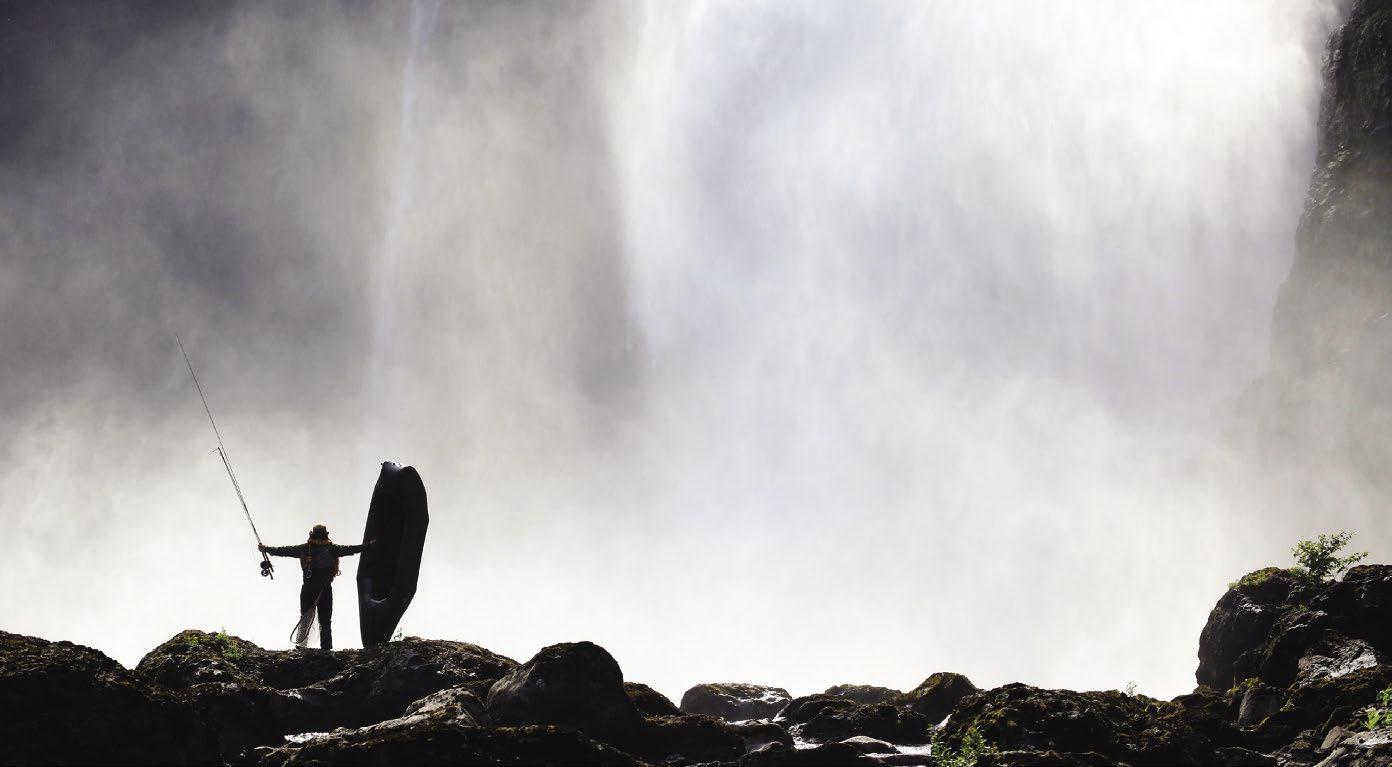
Santa Barbara Flyfishers Santa Barbara sbflyfishers.com facebook.com/Santa-BarbaraFlyfishers-110859760559894 sbff.treasurer@gmail.com
North Arkansas Fly Fishers Mtn Home northarkansasflyfisher.org @northarkansasflyfishers treasurer@northarkansasflyfishers.org
CALIFORNIA
Aguabonita Flyfishers Ridgecrest aguabonitaflyfishers.org info@abffclub.org
Granite Bay Flycasters Granite Bay gbflycasters.org president@gbflycasters.org
Hi-Desert Flyfishers Victorville hidesertflyfishers.com facebook.com/Hi-Desert-FlyFishers-942133159139436 hdff4trout@gmail.com
Kaweah Flyfishers Visalia kaweahflyfishers.org
Santa Clarita Casting Club Santa Clarita scflyfishing.org @santa.clarita.casting.club infoscflyfishing@gmail.com
Santa Cruz Fly Fly Fishing Santa Cruz santacruzflyfishermen.org info@santacruzflyfishing.org
Santa Lucia Flyfishers San Luis Obispo santaluciaflyfishers.com
Eagle Fly Fishing Anglers * Frisco eric.syverson@projecthealingwaters.org
Four Corners Fly Fishers * Pagosa Springs pjgrannt@gmail.com
The President’s Club at Fly Fishers International represents the highest level of financial commitment to the organization and comes with exclusive benefits and opportunities as a way of thanking donors for this level of generosity. Over the course of FFI’s history, the President’s Club has been instrumental in our ability to ensure the legacy of fly fishing for all fish in all waters. Members of the exclusive giving circle can support any program or project at FFI that most inspires them, and at a level that recognizes their level of giving, including Platinum, Gold, Silver, or Bronze.
Gunnison Gorge Anglers Montrose gunnisongorgeanglers.tu.org facebook.com/groups/610476489287752 gunnisongorgeanglersctu@gmail.com
High Plains Drifters Fly Fishing Club Littleton flyfisherscolorado.com @HPD.FFI info@flyfisherscolorado.com
Pueblo Tailwater Renegades Pueblo pueblotailwaterrenegades.wordpress.com @puebloflyfishing fam.4eternity@yahoo.com
LEARN ABOUT JOINING
FLY FISHERS INTERNATIONAL CLUB LISTING * Project Healing Waters Fly Fishing Affiliate Club
Join the Fly Fishers International flyfishersinternational.org/donate/presidents-club
operations@flyfishersinternational.org 406-222-9369 ext 4
CONNECTICUT
Connecticut Fly Fishermans Assoc East Hartford ctflyfish.org steinmillergary@yahoo.com
DELEWARE
302nd Mispillion River Vikings * Smyrna
FLORIDA
Backcountry Fly Fishers - Naples Naples flyfishingnaples.com @backcountryflyfishers bffpresident@flyfishingnaples.com
Bay Pines Veteran Fly Fishers * Bay Pines Baypinesveteranff@gmail.com
Florida Big Bend Flyfishers, Inc. Tallahassee @floridabigbendflyfishers fbbflyfishers@gmail.com
Fly Fishers of Northwest Florida Pensacola ffnwf.org @northwestflyfishers lsisney@cox.net
Gold Coast Fly Fishers Pompano Beach goldcoastflyfishers@yahoo.com
Mangrove Coast Fly Fishers Sarasota mcff.club facebook.com/groups/1472100149569391 mcff.membership@gmail.com
Mid-Coast Flyfishers Inc Edgewater mid-coastflyfishers.org @mcff @midcoastflyfishers midcoastfishersorg@gmail.com
Panhandle Fly Fishers Destin panhandleflyfishers.com panhandleflyfishers@gmail.com
Pasco Fly Fishers Club * New Port Richey tex.faulkner@projecthealingwaters.org
Sanibel FlyFishers Inc Sanibel @sanibelflyfishers sanibelff@gmail.com
Suncoast Fly Fishers St Petersburg suncoastflyfishers.com Pres_vp@suncoastflyfishers.com
Suwannee Valley Fly Fishing * Live Oak svflyfishing@gmail.com
SwFla Fly Fishers * Cape Coral ronnie.friedl@projecthealingwaters.org
Tarpon Coast Fly Fishers Inc Hernando Beach tarponcoastflyfishers.com @tarponcoastflyfishers tarponcoastflyfishers@shutterfly.com
Treasure Coast Stuart Fly Rodders Palm City
GEORGIA
Anchor Management * Valdosta tom.marcum@projecthealingwaters.org
Atlanta Fly Fishing Club Atlanta atlantaflyfishingclub.org @atlantaflyfishing president@atlantaflyfishingclub.org
Georgia Women Fly Fishers Atlanta georgiawomenflyfishing.com @GAWomensFlyFishing gawomenflyfishing@gmail.com
Operation Rivers to Recovery Buford or2r.org facebook.com/operationr2r
Team Georgia Competitive Fly Fishing Suwanee teamgeorgiaflyfishing.com teamgaflyfishingpresident@gmail.com
Veterans Flyfishing Inc Big Canoe veteransflyfishing.org drmauldin@windstream.net HAWAII
Hawaii Fly Fishers Kailua hawaiiflyfishers@gmail.com IDAHO
Boise Valley Fly Fishers Boise bvff.com @boisevalleyflyfishers president@bvff.com
Eastern Idaho Snake River Valley FFI Chapter* Idaho Falls scott.ferrara@projecthealingwaters.org
Kelly Creek Flycasters Lewiston kellycreekflycasters.org kellycreekflycasters@gmail.com
Magic Valley Fly Fishers Twin Falls magicvalleyflyfishers.com mvffeditor2014@hotmail.com
North Idaho Fly Casters Club Inc Coeur d’Alene northidahoflycasters.org northidahoflycasters@gmail.com
Snake River Cutthroats TU/FFF Idaho Falls snakerivercutthroats.org
Upper Snake River Fly Fishers Rexburg usrff.org usrff.org@gmail.com
ILLINOIS
DuPage River Fly Tyers Wheaton driftorg.com @driftorg support@driftorg.com
Rock River Fly Casters Consortium Rockford rockriverflycasters.club @rockriverflycasters mike@rockriverflycasters.club
INDIANA
St Joseph River Valley Fly Fishers South Bend sjrvff.com sjrvff@yahoo.com
Tri-State Veterans Fly Fishing * Evansville erikgoodge@gmail.com
IOWA
Hawkeye Fly Fishing Assoc Cedar Rapids hawkeyeflyfishing.com members@hawkeyeflyfishing.com
KANSAS
First City Fly Fishers * Leavenworth mjswanson44@gmail.com
Flatland Fly Fishers Wichita flatlandflyfishers.org flatlandflyfishers@gmail.com
Heart Of America Fly Fishers Shawnee Mission hoaff.org contact@hoaff.org
Prairie Fly Casters * Topeka anthony.daprato@projecthealingwaters.org
KENTUCKY
Northern Kentucky Fly Fishers Burlington nkff.org @nkfflyfishers info@nkff.org
Trifecta Fly Fishing Club * Louisville charles.hantz@projecthealingwaters.org
LOUISANA
Contraband Fly Casters Inc Lake Charles contrabandflycastersinc.net @contrabandflycasters contrabandflycastersinc@gmail.com
Gulf Coast Fly Tyers Kenner gcft.gulfcoastcouncilffi.org
Kisatchie Fly Fishers Alexandria kisatchiefly.org kff@laflyfish.com
New Orleans Fly Fishers Metairie neworleansflyfishers.com nolaffc@gmail.com
North Louisiana Fly Fishers Shreveport northlaflyfishers.org nlffclub@gmail.com
Red Stick Fly Fishers Baton Rouge rsff.blogspot.com facebook.com/Red-Stick-FlyFishers-148989515119780
MAINE
Northwoods Fly Fishers * Dixmont facebook.com/Project-Healing-WatersBangor-Maine-680843688761384/
MARYLAND
Antietam Fly Anglers Hagerstown afa-md.org @antietamflyanglers bruland3@outlook.com
Free State Fly Fishers Davidsonville fs-ff.com @fsffmd info@fs-ff.com
Friends of Lefty Kreh Frederick friendsofleftykreh.com andymekelburg@outlook.com
La Plata Fly Fishers * LaPlata Larry.braswell@Projecthealingwaters.org
Potomac Valley Fly Fishers Inc Frederick potomacvalleyflyfishers.club @pvflyfish contact@potomacvalleyflyfishers.club MASSACHUSETTS
Granite State Fly Fishers * Wakefield joe.cresta@projecthealingwaters.org
Gypsy Soul Fly Fishing * Beford adam.aronson@projecthealingwaters.org MICHIGAN
Anglers of the Au Sable Inc Grayling ausableanglers.org membership@ausableanglers.org
Bamboo Bend Project Inc Grayling bamboobend.org @bamboobendproject rrrebant@gmail.com
Brotherhood Of The Jungle Cock Bloomfield bojcmi.org bojcmich@gmail.com
Flygirls Of Michigan Benton Harbor flygirls.ws info@flygirls.ws
Grand Valley Fly Fishers Caledonia gvflyfishers@gmail.com
Michigan Fly Fishing Club Livonia mffc.org @theoriginalmichiganflyfishingclub admin@mffc.org
Pere Marquette Watershed Council Baldwin peremarquette.org pmwcinfo@gmail.com
Red Cedar Fly Fishers Okemos redcedarflyfishers.org presrcff@yahoo.com
West Michigan Hacklers Pentwater vetmedcenter243@gmail.com MINNESOTA
Fly Fishing Women of Minnesota Minneapolis flyfishingwomenmn.com ffwnmn@gmail.com
Lew Jewett Fly Fishers St. Paul lewjewett.org @lewjewettflyfishers lewjewett@hotmail.com
Pine to Prairie Fly Fishers Mehahga @pinetoprairieflyfishersIFFF pinetoprairieflyfishers@gmail.com
The Arrowhead Flyfishers Club Duluth arrowheadflyfishers.com facebook.com/Arrowhead-FlyFishers-138990146139573/ arrowheadflyfishers@outlook.com MISSISSIPPI
Chickasaw Fly Fishers Tupelo chickasawflyfishers@gmail.com
55 Fly Fishers International Club Listing
HOSSFLY - Historic Ocean Springs Saltwater FF Ocean Springs hossfly.org @hossfly hossflyclub@gmail.com
Magnolia Fly Fishers Madison magnoliaflyfishers.com johntindall7474@att.net MISSOURI
Capital City Fly Fishers Jefferson City capitalcityflyfishers.org
MAKO Fly Fishers Joplin makofly.org @makoflyfishers contact@makofly.org
Ozark Flyfishers St. Louis ozarkflyfishers.org ozarkiff@gmail.com
Southwest Missouri Fly Fishers Springfield facebook.com/Southwest-Missouri-FlyFishers-375595815789753/ swmissouriflyfishers@gmail.com
Tri-Lakes Fly Fishers Osceola facebook.com/Tri-Lakes-FlyFishers-463892860459055 trilakesflyfishers@gmail.com
MONTANA
Eastern Montana Fin Addicts * Roundup facebook.com/projecthealingwaters.org
Fly Fishers of the Bitterroot Victor flyfishersofthebitterroot.org flyfishersofthebitterroot@gmail.com
Glacier Country Fly Fishers Kalispell glaciercountryflyfishers.org @mtgrizzly67 glaciercountryflyfishers@gmail.com
NEBRASKA
Cornhusker Fly Fishers Lincoln cornhuskerflyfishers.org facebook.com/Cornhusker-FlyFishers-1433071293582678/ cornhuskerflyfishers@gmail.com
NEVADA
Carson Fly Fishing Club Carson City carsonflyfishing.club president@carsonflyfishingclub.com
Las Vegas Fly Fishing Club Las Vegas sntrout.com lasvegasflyfishing@gmail.com
Truckee River Fly Fishers Reno truckeeriverflyfishers.org tomsmith@truckeeriverflyfishers.org
NEW HAMPSHIRE
Nashua Fly Casting Assoc. Nashua nashuaflycasting.com nashuafca@gmail.com
NEW JERSEY
Jersey Shore Flyfishers * Jersey Shores morgan.woods@projecthealingwaters.org
SimplyFly-NJ Cherry Hill facebook.com/groups/6224755820928205 simplyflynj@gmail.com
South Jersey Coastal Fly Anglers Northfield southjerseycoastalflyanglers.com @sjcoastalflyanglers southjerseycoastalflyanglers@gmail.com
South Jersey Fly Fishers Inc West Deptford sjflyfishers.org sjflyfishers@gmail.com NEW YORK
Albany Program * Fort Edward Joshua.chase@projecthealingwaters.org
BC Flyfishers Endicott bcflyfishers.org @bcflyfishers bcflyfishers@yahoo.com
Capital District Fly Fishers Albany cdflyfishers.org @capitaldistrictflyfishers rodneypriddle@gmail.com
Castle Pointe * New York Cisco.Montanez@projecthealingwaters.org
Fly Fishers International of New York City * New York ira.krell@projecthealingwaters.org
Lake Erie Chapter FFI West Seneca lecffi.com lecfff@gmail.com
Patriot Anglers of the Delaware Water Gap * Port Jervis robert.giljr@projecthealingwaters.org
Twin Tiers Five Rivers Big Flats twintiersfff.org @twintiers5riversffi flyfishing@twintiersfff.org
Wild Trout Flyrodders Inc Cuddebackville wildtroutflyrodders.org info@wildtroutflyrodders.org
NORTH CAROLINA
Cape Fear Flyfishers Inc Southport capefearflyfishers.com cffrdd2006@gmail.com
Carolina Fly Fishing Club Salisbury carolinaflyfishingclub.org president@carolinaflyfishingclub.org
Crystal Coast - Camp Lejeune Fly Fishing Club Stella facebook.com/Crystal-Coast-CampLejeune-Fly-FishingClub-1511506142467852/ crystalcoastflyfishing@gmail.com
French Broad Fly Fishers Brevard frenchbroadflyfishers@gmail.com
Greenville Veterans Fly Fishing Club * Greenville jason.lee@projecthealingwaters.org
Liberty Point Fly Casters * Fayetteville bert_kinkead@hotmail.com
Onslow Bay - Camp Lejeune * Camp Lejeune chris.thompson@projecthealingwaters.org
Triangle Fly Fishers TU / FFF Raleigh triangleflyfishers.org contactff@gmail.com
NORTH DAKOTA
Northern Plains Fly Fishers * Bizmark marc.taylor@projecthealingwaters.org OHIO
Buckeye United Fly Fishers Cincinnati buckeyeflyfishers.com @buckeyeflyfishers info@buckeyeflyfishers.com
Firelands Fly Fishers Avon firelandsflyfishers.com facebook.com/Firelandsflyfishers-414551228741694/ firelandsflyfishers@roadrunner.com
Land of Legend Fly Fishers Newark landoflegendflyfishers@gmail.com
Miami Valley Fly Fishers Inc Dayton mvff.us mvffemail@gmail.com
Mohican Fly Fishers Of Ohio Bellville mohicanflyfishersofohio.com @mohicanflyfishersofohio bowermab@yahoo.com
North Branch Boys Inc Toledo northbranchclub.org northbranchboys@gmail.com
North Coast Fly Fishers Painesville northcoastflyfishers.com northcoastflyfishers@gmail.com
Northeast Ohio Fly Fishers * Rocky River richard.fox@projecthealingwaters.org
OKLAHOMA
Green Country Fly Fishers Bartlesville greencountryflyfishers.com sectres@greencountryflyfishers.com
OKC Anglers Fly Fishing Club * Oklahoma City satterelli.phwff@gmail.com
Oklahoma Fly Fishers Tulsa oklahomaflyfishers.org oklahomaflyfishers@gmail.com
Redneck Fly Fishing * Tulsa russell.dunlap@projecthealingwaters.org
Tulsa Fly Fishers Tulsa tu420.com facebook.com/groups/189956484385848 tu420membership@gmail.com
OREGON
Cascade Family Flyfishers Springfield cascadefamilyflyfishers.com treasurer@cascadefamilyflyfishers.com
Central Coast Fly Fishers Waldport sites.google.comview/flyfisherscentralcoast flyfisherscentralcoast@gmail.com
Central Oregon Fly Tyers Guild Sisters steelefly@msn.com
Central Oregon Flyfishers Bend coflyfishers.org @centraloregonflyfishersclub president@coflyfishers.org
Fly Fishing Veterans Sutherlin flyfishingveterans.org dmyers@flyfishingveterans.org
Klamath Country Fly Casters Klamath Falls klamathcountryflycasters.com @klamathcountryflycasters kcflycasters@gmail.com
McKenzie Fly Fishers Eugene mckenzieflyfishers.org mckenzieflyfishers@gmail.com
North Santiam Spey Casters Salem
Rainland Fly Casters Astoria rainlandflycasters.com rick@eyeofnewt.net
Rogue Fly Fishers Inc Medford rogueflyfishers.org facebook.com/rogueflyfishers -169212809767931 rffboard@gmail.com
Santiam Flycasters Inc Salem santiamflycasters.com @santiamflycasters santiamflycasters@yahoo.com
Southern Oregon Fly Fishers Grants Pass info@soff.org
Stonefly Maidens Fly Fishing Club Lake Oswego stoneflymaidens.club president@stoneflymaidens.org
Umpqua Valley Fly Fishers Roseburg umpquavalleyflyfishers.org @umpquavalleyflyfishers jdhfishon@yahoo.com
Washington County Flyfishers Hillboro washingtoncountyflyfishers.com President@washingtoncountyflyfishers.com
PENNSYLVANIA
Bux-Mont Freedom Fly Fishers * Chalfont jerrycoviello@gmail.com
Cumberland Valley TU FFF Carlisle pacvtu.org cvtu052@gmail.com
Delaware Valley Fly Fishers Churchville delawarevalleyflyfishers.org @dvflyfisher delawarevalleyflyfishers@gmail.com
Juliana League Fly Fishers Kimberton djlflyfishers.org @damejulianaleague djlffpa@gmail.com
Keystone Fly Fishers Inc. Franklin keystoneflyfishers keystoneflyfishers1@gmail.com
56 FlyFisher Fall/Winter 2022
Presque Isle Fly Casting and Fly Fishing Association Erie craig.brandick@projecthealingwaters.org
Seneca Fly Fishers Port Allegany @senecatroutunlimited tuseneca@gmail.com
Juniata Fly Fishing Club * Harrisberg East glenn.klinger@projecthealingwaters.org
SOUTH DAKOTA
Fort Meade Anglers * Summerset Christiane.budge@gmail.com
Rushmore Fly Fishing Veterans * Rapid City maineyankee1@hotmail.com
South Dakota Vets on the Fly Rapid City sdvotf.com sdvetsonthefly@gmail.com
TENNESSEE
East Tennessee Fly Fishers * Johnson Ciity russ.ambrose@projecthealingwaters.org
Mid-South Fly Fishers Memphis msff.org lack.josha@gmail.com
Middle Tennessee Fly Fishers Nashville middletennesseeflyfishers.org @mtff.org rlcasalone@bellsouth.net
North Central Tennessee Fly Fishing * Clarkville/ Ft Campbell chris.fields2327@yahoo.com
Reel Nashville Veterans Fly Fishers * Nashville tony.mitchell@projecthealingwaters.org
Tennessee Drifters Fly Fishers * Murfreesboro facebook.com/Project-Healing-WatersMurfreesboro-TN-369420073537989
Volunteer Fly Fishers * Knoxville jnoewillis@gmail.com
TEXAS
Abilene Fly Fishers Abilene @abileneflyfishers abileneflyfishers@gmail.com
Alamo Fly Fishers San Antonio alamoflyfishers.org @alamoflyfishers alamoflyfishers@gmail.com
Austin Fly Fishers Austin austinflyfishers.com @atxflyfishers info@austinflyfishers.com
Collin County Fly Fishers * Dallas ed.bowen@projectheallingwaters.org
Collin County Fly Fishing Club Wylie CollinCountyFlyFishing.org facebook.com/groups/801732120018995 contact@collincountyflyfishing.org
Conroe Fly Fishers * Conroe txfritz4134@suddenlink.net
Corpus Christi Fly Fishers Inc Corpus Christi corpuschristiflyfishers.com @corpuscristiflyfishers twolooseboards@yahoo.com
Dallas Fly Fishers, Inc. Dallas dallasflyfishers.org dallasflyfishers@gmail.com
Fort Worth Fly Fishers Fort Worth fortworthflyfishers.org @fortworthflyfishers president@fortworthflyfishers.org
Kekoa Outdoors Melissa info@kekoaoutdoors.org
Lubbock Fly Fishers Inc Lubbock lubbockflyfishers.org facebook.com/groups/1667373560217006/ lubbockflyfishers@gmail.com
New Braunfels Fly Fishers New Braunfels @newbraunfelsflyfishers info@newbraunfelsflyfishers.org
Pineywoods Fly Fishers * Lufkin pwff@usa.com
Red River Fly Fishers Sherman rrff.org rrflyfishers@gmail.com
Rowlett Fishers * Royse City derrick.meis@projecthealingwaters.org
San Gabriel Fly Fishers Inc Georgetown sgflyfishers.com @sangabrielflyfishers sgflyfishers@gmail.com
Texas Flyfishers Houston texasflyfishers.org @texasflyfishers txflyfishers@gmail.com
Texas Hill Country Fly Fishers Fredericksburg thcff.org @oktoberfisch president@thcff.org
Texas Women Fly Fishers Austin @texaswomen tightlines@twff.net UTAH
Bonneville Fly Fishers Salt Lake City bonnevilleflyfishers.com fred.jepson@gmail.com
Liberty Wells Flyfishers * Salt Lake City steve.moritz@projecthealingwaters.org
VERMONT
Green Mountain Veterans * Jeffersonville GreenMountainPHWFF/ VIRGINIA
Falmouth Flats Fly Fishers Fredericksburg falmouthflatsflyfishers.org falmouthflatsflyfishers@yahoo.com
Fly Fishers of Virginia Inc. Richmond flyfishersofvirginia.org info@flyfishersofva.com
Fly Fishers of Western Virginia * Southwest Virginia geoff.barger@projecthealingwaters.org
Shenandoah Valley Fly Fishing * Shenandoah Valley charles.howdyshell@projecthealingwaters. org
Tidal Potomac Fly Rodders Arlington tpfr.org reganeb@mindspring.com
Veteran Flyfishers of Hampton Roads * Hampton Roads ricky.rangel@projecthealingwaters.org WASHINGTON
Alpine Fly Fishers Lake Tapps alpineflyfishers.org alpineflyfishers@gmail.com
Bainbridge Island Fly Fishers Bainbridge Island bainbridgeislandflyfishers.wordpress.com bainbridgeislandflyfishers@gmail.com
Caring Fly Fishers of Washington * Seattle jim.mcroberts@projecthealingwaters.org
Clark Skamania Flyfishers Vancouver clark-skamania-flyfishers.org susan.cox@gmail.com
Clearwater Flycasters Pullman clearwaterflycasters.com kaylynn4341@gmail.com
Cowlitz Fly Anglers Longview cowlitzflyanglers@gmail.com
Eastern Washington Fly Fishing Club * Spokane craig.adams@projecthealingwaters.org
Evergreen Fly Fishing Club Everett evergreenflyclub.org @EFFCWashington atkinson.es@comcast.net
Fidalgo Fly Fishers Anacortes fidalgoflyfishers.com fidalgoflyfishersmail@gmail.com
Inland Empire Fly Fishing Club Spokane ieffc.org mail.ieffc@gmail.com
Lower Columbia Flyfishers Longview lowercolumbiaflyfishers.org lowercolumbiaflyfishers@gmail.com
Northwest Fly Anglers Seattle northwestflyanglers.org nfa@northwestflyangers.org
Olympic Fly Fishers of Edmonds Edmonds olympicflyfishers.com facebook.com/Olympic-Fly-Fishers-ofEdmonds-Washington-100516888107810 off.treasurer@gmail.com
Overlake Fly Fishing Club Bellevue offc.org @overlakeflyfishingclub president@offc.org
Puget Sound Fly Fishers Club Tacoma facebook.com/PugetSoundFlyFishers
South Sound Fly Fishers Olympia southsoundflyfishers.org @southsoundflyfishers southsoundflyfishers@gmail.com
Spokane Fly Fishers LLC Spokane spokaneflyfishers.com president@spokaneflyfishers.com
Washington Fly Fishing Club Seattle wffc.com jlgoedhart@gmail.com
Wenatchee Valley Fly Fishers Wenatchee wenatcheevalleyflyfishers.com richmond.jj@outlook.com
WEST VIRGINIA
Creekside Anglers Shepherdstown creeksideanglers.org adams4849@comcast.net
WISCONSIN
Classic Anglers of Wisconsin Pulaski groupspaces.comclassicanglers @classic-anglers-of-wisconsin nregister@netnet.net
Fox Valley Veteran Anglers * Krakow 5grizzlys@reagan.com WYOMING
Central Wyoming Fly Fishers * Casper Bruce.chandler@projecthealingwaters.org
Popo Agie Anglers Lander popoagieanglers.wordpress.com phunker@wyoming.com
INTERNATIONAL
Japan Fly Fishing Association (JFFA) Kofu jffa1205.com jffa20151205@gmail.com
Mosca Club Piacenza Piacenza moscaclubpiacenza.weebly.com @moscaclubpiacenza moscaclubpiacenza1988@gmail.com
57 Fly Fishers International Club Listing
Terry Greiner
The Great Lakes Council and Fly Fishers International lost a devoted volunteer and great friend when Terry Greiner passed away on August 21, 2022, at age 70.

Terry was a family man, jokester and teller of tall tales. Terry never met a stranger who didn’t leave with one or two bad jokes to share. Those who were introduced to him for the first time were soon counted among his friends. Terry married his beloved wife Nancy in 1974 and they became parents to three children, Kyle, Lindsey and Scott.
Terry’s favorite activity was fly fishing—not just doing the activity itself, but living it. Terry promoted fishing, read about fishing and tied flies for fishing. His were the ultimate fish stories. A true Michigander, Terry fished the Muskegon, the Au Sable, the Pere Marquette and just about any other piece of water he could find. He was an accomplished spey caster and especially enjoyed swinging flies for steelhead.
Terry left his mark in the fly fishing community, particularly across Michigan. He was a tireless FFI volunteer. He served as President of the Great Lakes Council, GLC membership chair, and held numerous leadership positions in his local FFI Club, the Red Cedars Fly Fishers. Terry also served on a number of FFI committees at the national level.
Terry was a good friend to everyone he met and will be missed by all those he befriended. As his family said, the trout and salmon can rest easy now.
58 FlyFisher Fall/Winter 2022 TRIBUTE
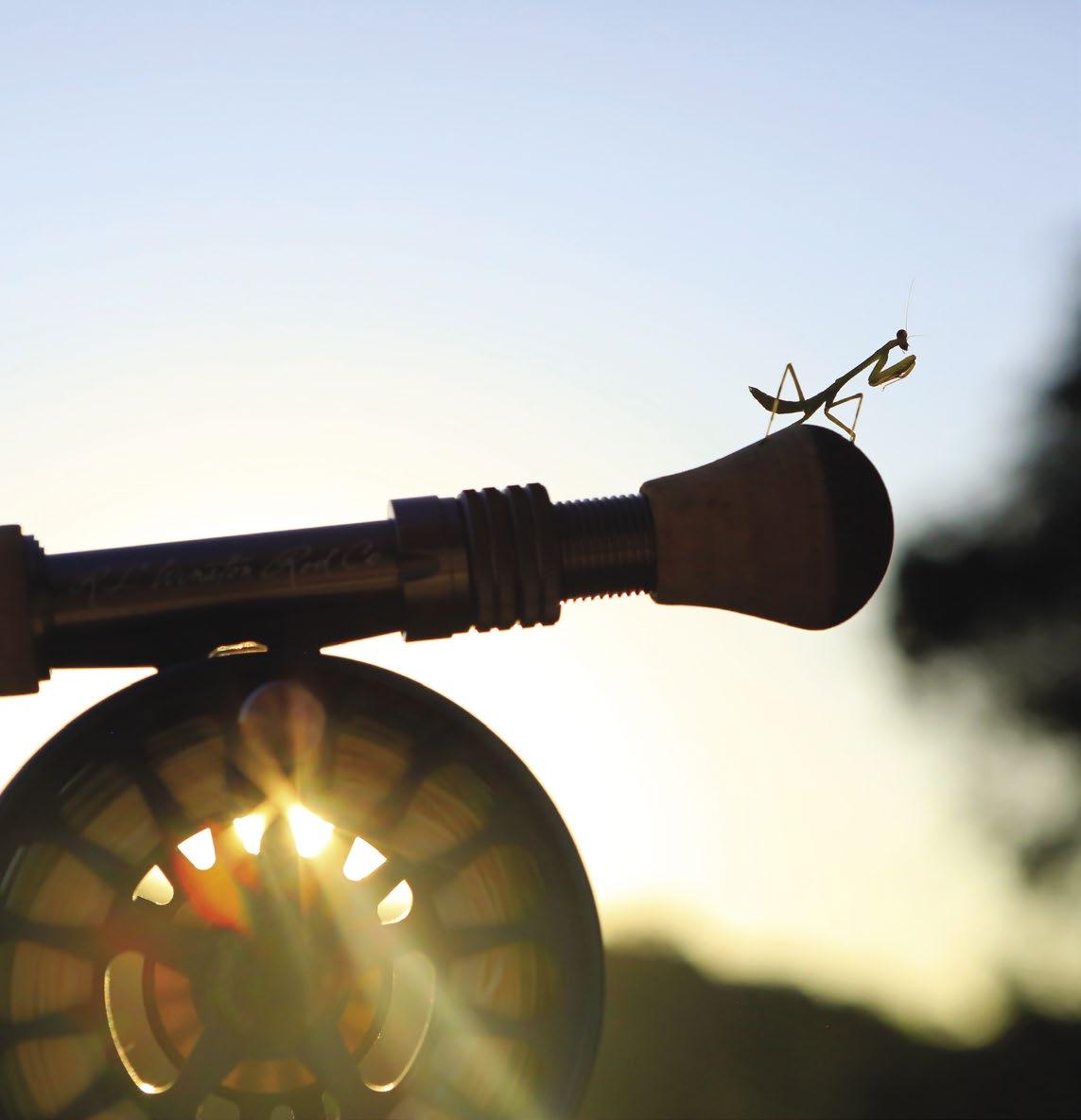

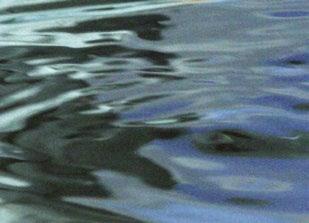



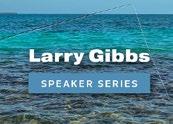
FFI Forum flyfishersinternational.org/virtual-expo @flyfishersinternational ALL FISH, ALL WATERS ® We e x press o u r s incere grat itude t o o ur s ponsors, volunteers, an d t he leadership team w ho produced t he FFI Virtual Expo 2 022 . T HANK YOU!
The President’s Club at Fly Fishers International represents the highest level of financial commitment to the organization and comes with exclusive benefits and opportunities as a way of thanking donors for this level of generosity. Over the course of FFI’s history, the President’s Club has been instrumental in our ability to ensure the legacy of fly fishing for all fish in all waters. Members of the exclusive giving circle can support any program or project at FFI that most inspires them, and at a level that recognizes their level of giving, including Platinum, Gold, Silver, or Bronze.


Join the Fly Fishers International flyfishersinternational.org/donate/presidents-club LEARN ABOUT JOINING operations@flyfishersinternational.org 406-222-9369 ext 4





 Cover and contents image credit: Eric and Andrew Braker
Cover and contents image credit: Eric and Andrew Braker






























 Photo Will Parson, Chesapeake Bay Program
Photo Will Parson, Chesapeake Bay Program










 Photo Eric and Andrew Braker
Photo Eric and Andrew Braker





 Blake Parsons
Blake Parsons is Communications Director at Fly Fishers International. He’s rarely far from a fly rod, having escaped a career in advertising to make the rounds as fly shop guy and guide. Blake lives in Nashville, Tennessee with his wife Ally, who out fishes him on a regular basis.
Blake Parsons
Blake Parsons is Communications Director at Fly Fishers International. He’s rarely far from a fly rod, having escaped a career in advertising to make the rounds as fly shop guy and guide. Blake lives in Nashville, Tennessee with his wife Ally, who out fishes him on a regular basis.





























